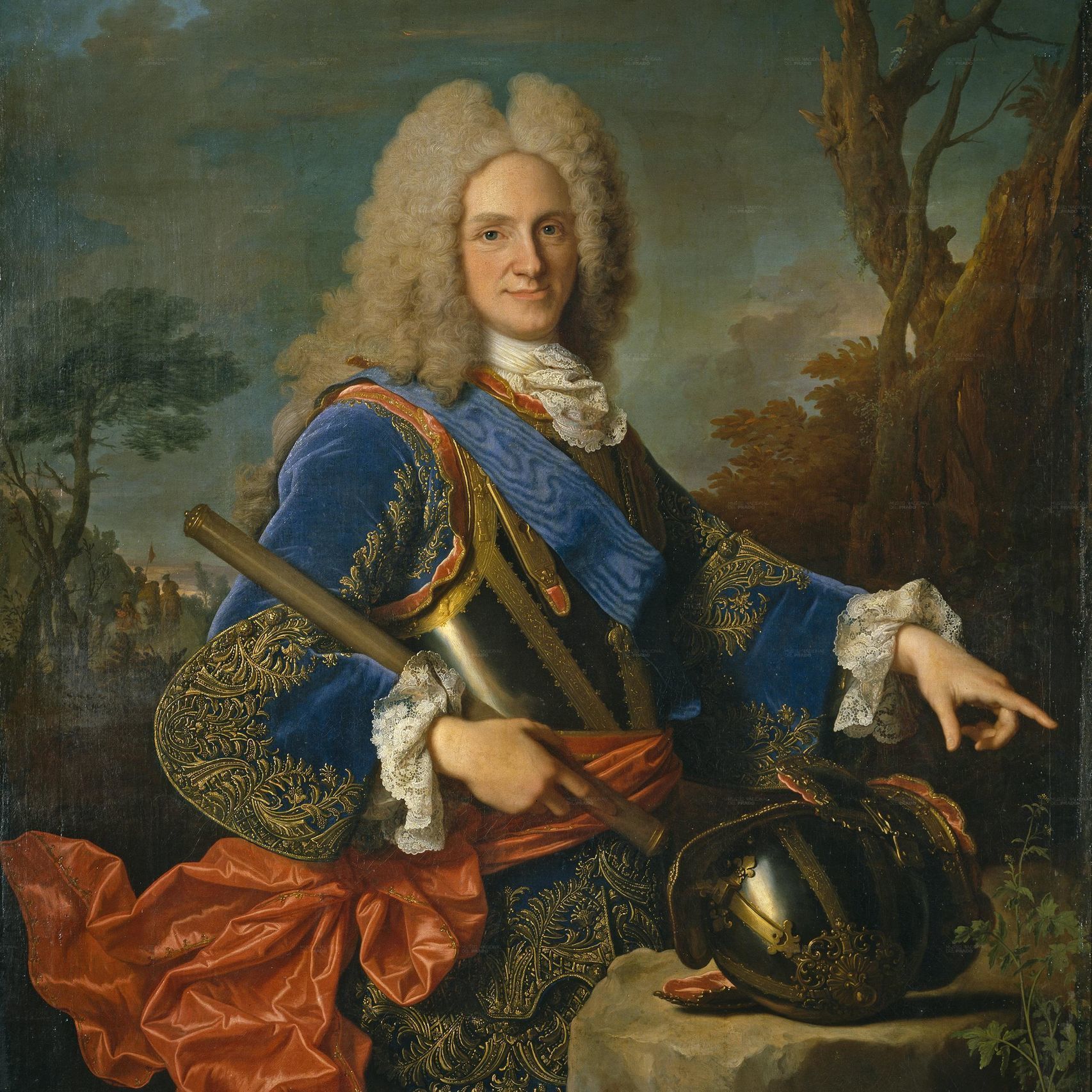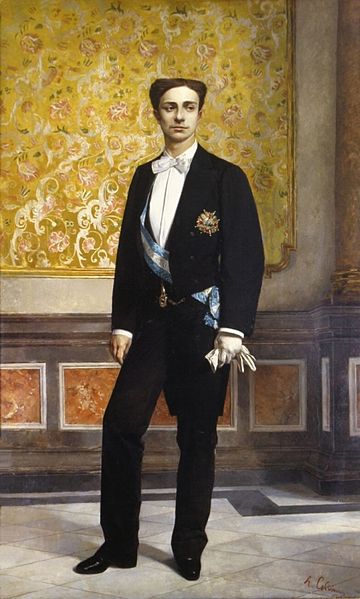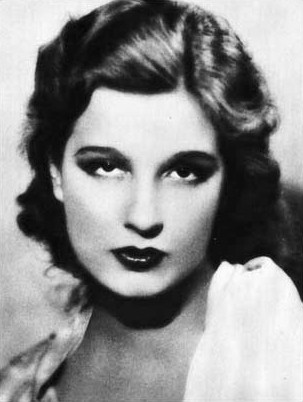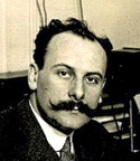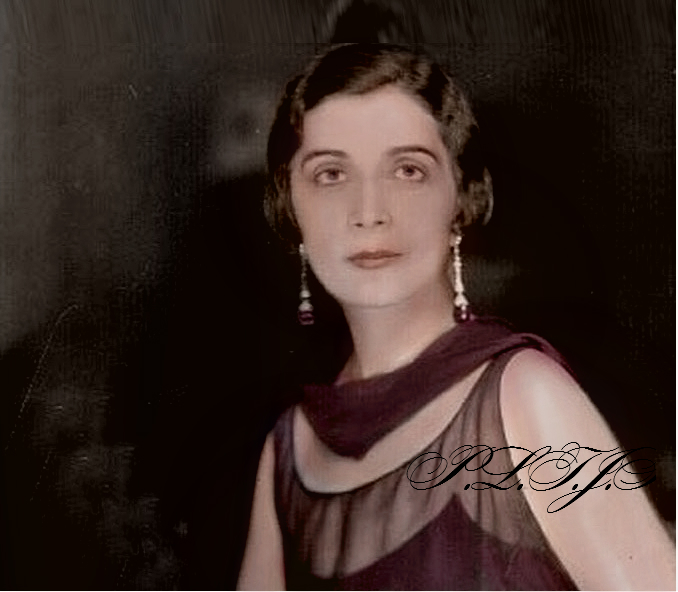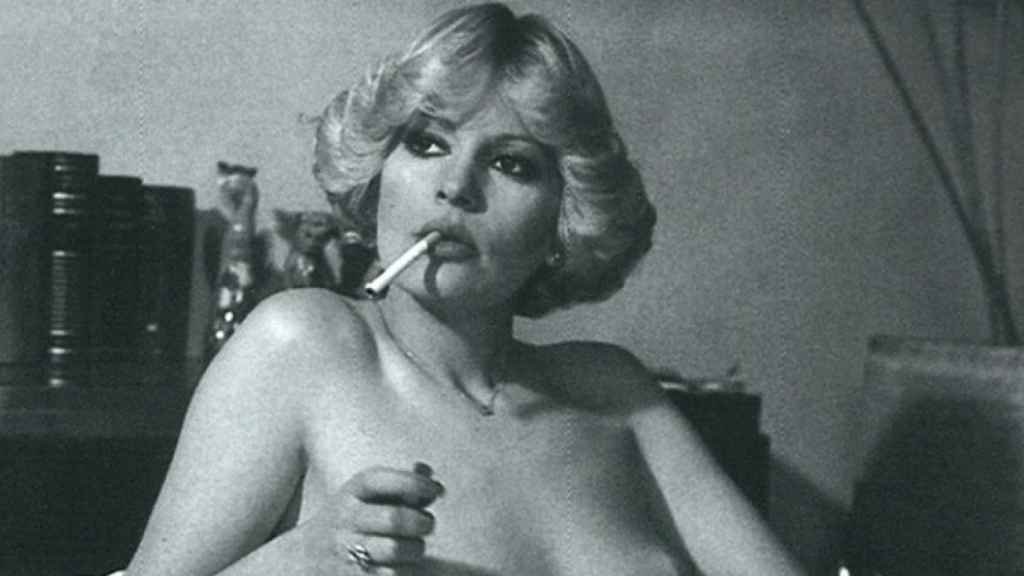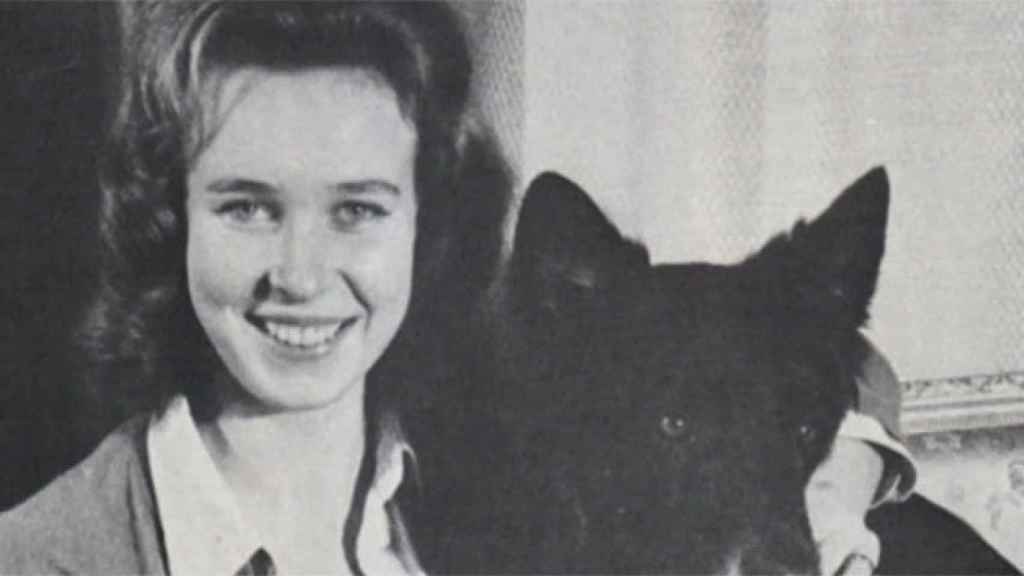King of Hispania
710-712
Son of: Teodofredo of the Visigoths & Riciberga
Husband of: Egilona, Queen of the Visigoths (659-718)
His lover was:
"[T]hr fabled Rodrigo, from his capital at Toledo, actually ruled over Spain in the year 709, and that he was, directly or indirectly, the cause of the invasion of the Moors. According to the commonly accepted story, the moral condition of Spain at the beginning of the eighth century was most deplorable. The Goths had lost that reputation for honesty and chastity which in the earlier days of their power had distinguished them from the Romans. Rodrigo, 'the last of the Goths,' lived a life of such flagrant profligacy that the coming of the Moors was but just punishment for all his sins. As Miss Yonge has remarked, 'the fall of Gothic Spain was one of the disasters that served to justify the saying that all great catastrophes are caused by women.' The woman in the present instance was Florinda, often called La Cava, reputed to be the daughter of Count Julian, commander of the south of Spain in charge of the fortress of Ceuta. Although Rodrigo already possessed a wife, Egilona, who was a brilliant, able, and beautiful woman, he was a man of little moral force and had a roving eye and lusty passions. Seeing Florinda once upon a time, he coveted her, succeeded in winning her affections, and was not content until he had betrayed her confidence and brought dishonor upon her and her father. Count Julian, filled with a righteous anger at this unwarranted act on the part of his liege lord, openly revolted, called in the Moors, and unwittingly opened his country to an invader who would be slow to leave. . . ." (Women of the Romance Countries)
" . . . In Al-Andalus any Christian slave girl who had embraced Islam was named Roumiya. Also the legendary lover of King Roderic and daughter of Count Julian is named La Cava Rumía — her affair being the putative cause of the Moorish invasion of Hispania in AD 711. . . ." (Wikipedia)
"According to the legend of Don Rodrigo, the last Gothic king, the loss of Spain was a result of his libido. It is said that he saw a beautiful maiden, Florinda de La Cava, bathing in the waters of the Tajo and fell in love with her. Don Rodrigo took Florinda as his love, without the permission of her father, Count Julian, governor of Ceuta in the Straits of Gibraltar. When Count Julian learned of the relationship, he felt that his honor had been slighted. That is the reason why he helped the Moors invade Spain in 711. The fate of Don Rodrigo is unknown. Some say that he died in the ocean, some say that he went to a hermitage before being eaten alive by a snake, and still others say that he went mad with grief for losing Spain." (Clare's Historical Spanish Rage)
"In the eighth century a nobleman Julien had sent one of his daughters to King Rodrigo's, also known as Roderick, castle for her education and betterment. After a torrid love affair with Rodrigo she became heavy with child. This was an effrontery (sic) to Julien's honor. With vengeance on his mind, during the year 710 AD Julien traveled to northern Africa to enlist the aid of the people we have called los Moros." (Ayes: 3)
" . . . The rare beauty of Florinda soon attracted the notice of Roderick, who became deeply enamoured of her, and vainly sought a return of affection. The resistance opposed to his wishes but served as an incentive to the passion of the king, inflaming a temperament but too ardent by nature, and, in an unguarded moment, forgetful of consequences, he is said to have obtained by violence that which was denied to love. The enraged Florinda immediately wrote to her father, then in Africa, demanding vengeance, and to punish a private wrong the traitor count leagued with Infidels, and betrayed into their hands both king and country. Be this at it may, his daughter's dishonor was the pretext of the Count's treachery. . . ." (George: 18)
Physical appearance & personal qualities.
" . . . Roderick is described as having been a prince of excellent natural parts, resolute, bountiful, and of winning manners, but implacable in his resentments. . . ." (George: 17)
Personal & family background.
" . . . The fatal cause of his ruin, and that of his kingdom, was Florinda, or, as she is often called by ancient writers, Cava, the daughter of Count Julian, one of the most powerful of the Gothic nobles, governor, at the time, of that part of Barbary called Mauritania Tangitana, then subject to the Goths. Count Julian had also the government of that part of Spain adjoining the straits of Gibralter (sic), and was besides possessed of a large estate near Consuegra. . . ." (George: 17)
" . . . By blaming Juana for the Portuguese invasion of Castile, Palencia conjures up for his readers another ambiguously stigmatized woman, La Cava, the lover of the last Visigothic King Rodrigo, who was also held responsible for the eighth century invasion and conquest of Visigothic Spain by the Moors, viewed as a violation. . . ." (Weissberger: 89)
" . . . By blaming Juana for the Portuguese invasion of Castile, Palencia conjures up for his readers another ambiguously stigmatized woman, La Cava, the lover of the last Visigothic King Rodrigo, who was also held responsible for the eighth century invasion and conquest of Visigothic Spain by the Moors, viewed as a violation. . . ." (Weissberger: 89)
 |
| Philip I of Castile |
King of Castile & Leon

Husband of: Juana, Queen of Castile.
" . . . Philip was eighteen at the time -- only two years older than Juana herself. Word had it that he was the most handsome prince in Europe (a reputation that stayed with him beyond death, leaving him with the epitaph 'the Handsome'( and he had already written Juana a long love letter in Latin (or probably had someone write it for him, since for good reason Philip is no known as 'the Educated'). As part of the pact agreed between her parents and Maximilian, Juana was to sail to meet Philip in Flanders for the marriage and remain there in his household, something that made Juana uneasy to say the lest, but she was raised from a very early age to not only expect but look forward to marriage as a pleasant Christian duty." (Ruthless Rulers: The Real Lives of Europe's Most Infamous Tyrants)
Love at first sight.
"Juana, having grown up in the stifling, moralistic atmosphere of the Spanish court, was satisfyingly overwhelmed by the free spirit she found at Flanders. Any ancieties and fears she might have still harbored despite herself were washed away when she first saw her intended at the Hotel de Berthout. Philip, a very attractive and athletic young man, did indeed live up to his reputation, and Juana was inevitably smitten with this prince who exceeded all her expectations. He must have been suitable implressed with his dark-haired bride, because once formal introductions were done he ordered the nearest priest to marry them on the spot. Afterwards, the royal teenagers made love th einstant they could sneak away. With the next day came the formal church ceremony and a lavish celebration. To Juana, it must have felt a fairy-tale ending." (Ruthless Rulers)
Felipe's extreme beauty of personal appearance.
"The extreme beauty of Philip's personal appearance obtained for him the surname of 'fair;' his other less flattering sobriquet of 'croit conseil,' was given him from his proneness to listen to the advice of the flatterers by whom he was surrounded. That he possessed but little capacity for affairs, is evident from his conduct in Guelderland, and his easy surrender of his rights over Friezland. Nevertheless his gentle and pacific temper rendered him a far more suitable governor for the Netherlanders than either of his predecessors, Maximilian of Charles. During his short reign, he neither violated their privileges at home, nor engaged them in ruins and unnecessary wars abroad . . . ." (History of Holland, from the Beginning of the Tenth to the End of the Eighteenth Century: 333)
Felipe the Handsome & Juana the Mad in love.
"As far as arranged royal marriages west, this one looked promising. Philip found Joana quite alluring when he first saw her in 1496, a perk not to be underestimated in an era when strangers were wed to strangers without the slightest regard to compatibility. For her part, Joanna was immediately entranced by Philip's good looks and charm. Their first meeting went so well, in fact, that Philip insisted the wedding ceremony be arranged right away so he could bed his bride without delay. Apparently the sex was fantastic and Joanna, who had been raised in the court of her ultra-conservative Catholic parents, was intoxicated. Philip, on the other hand, was atypical royal male who felt no particular allegiance to the marital bed. As Philip roamed, Joanna became more and more despondent. She breathed only for him, ignoring even the religious devotion that had once sustained her. Her neediness, however, only served to bring out Philip's inherent nastiness. He parceled out sex to his grateful wife, alternating it with threats of violence to subjugate her further. Joanna's familiar Spanish staff was sent away, and she was left isolated in Philip's hostile Flemish court. She was too paranoid even to write her parents. . . ." (A Treasury of Royal Scandals: 36-)
 |
| @Hilde's Home |
Juana left his new-born son behind in Spain to follow her husband to Flanders where he was philandering with his bevy of mistresses.
"Queen Juana I of Castile was highly-strung and physically addicted to her dashing but adulterous husband, Philip the Handsome of Austria. Her passionate ardor was to grow wildly out of control, leading to a profound jealousy, mental instability, and deranged antics that earned her the title 'Juana la Loca' (Joanna the Mad). As a child, Juana was sullen, moody and solitary. Some interpreted her reclusive and haughty behaviour as the hallmarks of natural majestic dignity, but those close to her were disturbed to recognize in her moods a resemblance to her grandmother, the mad Queen Isabel of Portugal. At the age of sixteen, and on the brink of her sexual awakening, Juana was shipped off to Flanders to marry the only son of the Emperor Maximilian I, the tall, dark and insatiably virile Philip the Handsome. By all reports, the couple were instantly attracted to one another and enjoyed an actively carnal relationship. The passion soon grew one-sided however, with Philip reverting to his bachelor pastimes of feasting, drinking, and bed-hopping. Juana, incensed by his unfaithfulness, flew into uncontrollable rages, spending nights pounding on the walls of her lonely bedchamber. Philip refused to countenance her behaviour, and punished her further by withdrawing all conjugal visits. Sexually frustrated and increasingly unbalance, Juana grew more hysterical as her desire for her husband intensified. Following the deaths of her elder brother and sister, Juana returned to Spain as heiress, taking Philip with her. On receiving a cold welcome from her mother, and with a husband desperate to return to Flanders and his bevy of mistresses, the pregnant Juana sunk further into despondency and irrationality. She lashed out at servants, kicking and screaming, and biting, and she hurled heinous insults. Her family locked the deranged Juana in the Castle of La Mota and her philandering husband returned to Flanders without her. Imprisoned and pining for her husband, Juana's obsession grew to extravagant proportions. After giving birth to her fourth child, Ferdinand, she managed to make her way back to Flanders, leaving her son behind. She arrived home to find a mistress at her husband's side. Juana attached brutally, hacking the woman's hair off in public. Desperate to regain her husband's affection, Juana turned to sorcery, spending days locked in her rooms concocting ineffective love potions." (Mad kings & queens: 32)
Felipe's legendary womanizing.
"It was not too long before the cracks began to appear in the storybook facade. Money sent for the maintenance of Juana's household by her parents fell into Philip's hands and never touched Juana's Many of Juana's Spanish servants were dismissed and replaced by natives, robbing her of even the slightest connection to her homeland. Even worse in Juana's eyes was Philip's constant infidelity. At the time, it was not unusual, but rather expected, that man of noble birth would have his mistresses and occasional visits to the brothels. Even in such a culture, however, Philip's womanizing was legendary. A contemporary noted, 'Nothing seemed better to him than women's pretty faces'. His insatiable sexual appetite, especially for blonde virgins, was the talk of the court, but he never seemed to neglect his duties as a royal husband not did Juana force him to sleep on the couch, so to speak. She would have six children by him, the first three born within the first few years of the marriage." (Ruthless Rulers)
"It was not too long before the cracks began to appear in the storybook facade. Money sent for the maintenance of Juana's household by her parents fell into Philip's hands and never touched Juana's Many of Juana's Spanish servants were dismissed and replaced by natives, robbing her of even the slightest connection to her homeland. Even worse in Juana's eyes was Philip's constant infidelity. At the time, it was not unusual, but rather expected, that man of noble birth would have his mistresses and occasional visits to the brothels. Even in such a culture, however, Philip's womanizing was legendary. A contemporary noted, 'Nothing seemed better to him than women's pretty faces'. His insatiable sexual appetite, especially for blonde virgins, was the talk of the court, but he never seemed to neglect his duties as a royal husband not did Juana force him to sleep on the couch, so to speak. She would have six children by him, the first three born within the first few years of the marriage." (Ruthless Rulers)
Royal wife who loved her man beyond measure.
"Juana saw the Netherlands as her home, a place where she could fulfill her marital duties, as opposed to Spain, where she was tied to her parents' designs on her life. Her entrance to the Netherlands was completely different than her first arrival. This time she was met not only by a celebrating crowd, but her husband came to meet her ship at Blanbenberghe. There was a problem, though. Philippe’s behavior towards her had changed. A chronicler at the time wrote, “Donna Juana felt the change which had taken place in the Prince’s love. His manner to her was very different from what it had been; and as a woman who loved him beyond measure, she sought to discover that the cause of the alteration might be. She was told that the Archduke had a mistress, an exceedingly handsome noblewoman, with whom he was passionately in love” (Charol, pp. 78-79). Juana soon discovered the woman to be a young, blonde Flemish beauty and a confrontation erupted between the two women, with the result Juana had the young woman’s hair cut short. Philip reacted with physical violence towards Juana and she took to her bed. All her anxieties toward her husband had come true and all her sacrifices appeared meaningless." (Juana "the Mad"; Queen of a World Empire)
Effect of Felipe's philandering on his wife.
" . . . [S]omething in Juana snapped and even back in Flanders she could not maintain the empty illusion of happiness. Anxious about her own black hair and dark complexion in the face of the native blonde women Philip preferred, Juana one afternoon walked in on a blonde mistress of Philip reading a love letter from him. When Juana ordered the girl to give her the letter, the woman instead ripped the paper to pieces and swallowed them one by one. Juana abruptly grabbed a pair of scissors, attacked the stunned woman, sheared off all her hair, and slashed her in the face. When work got to Philip, he took his wrath out on Juana personally, possible even to the point of beating her. From then on, Philip and his servants referred to Juana as 'the terror' and often kept her under lock and key, sometimes even with a guard standing outside. But the worst punishment could could and did inflict was denying his wife his body. One report claimed that once, after a heated argument about Juana's servants, Philip went to bed in a separate room under Juana's without a word. All night, Juana knelt at the floor, first banging against it with a rock and then hacking away at it with a knife, crying out, 'Are you there? Are you there? Are you there?'" (Ruthless Rulers)
"Whereas Philip was happy to continue leading the life of a bachelor gay, Juana's sheltered childhood had led her to expect more from marriage -- even a politically arranged one. Whenever she saw her husband enjoying the company of another woman, she flew into a jealous rage. She began sinking into depression and suffering anxious fainting fits. She became fiery and temperamental, haughty and obstinate. Philip's response was to punish her by steering clear of her bedroom for days, leaving her to cry herself to sleep and to bang her body against the wall in frustration. Yet in spite of his unsympathetic behaviour, she remained hopelessly -- madly -- in love with him." (Royalty's Strangest Characters)
 |
| Carlos I of Spain |
 |
| Carlos I & queen |
(1500-1588)
His lovers were:
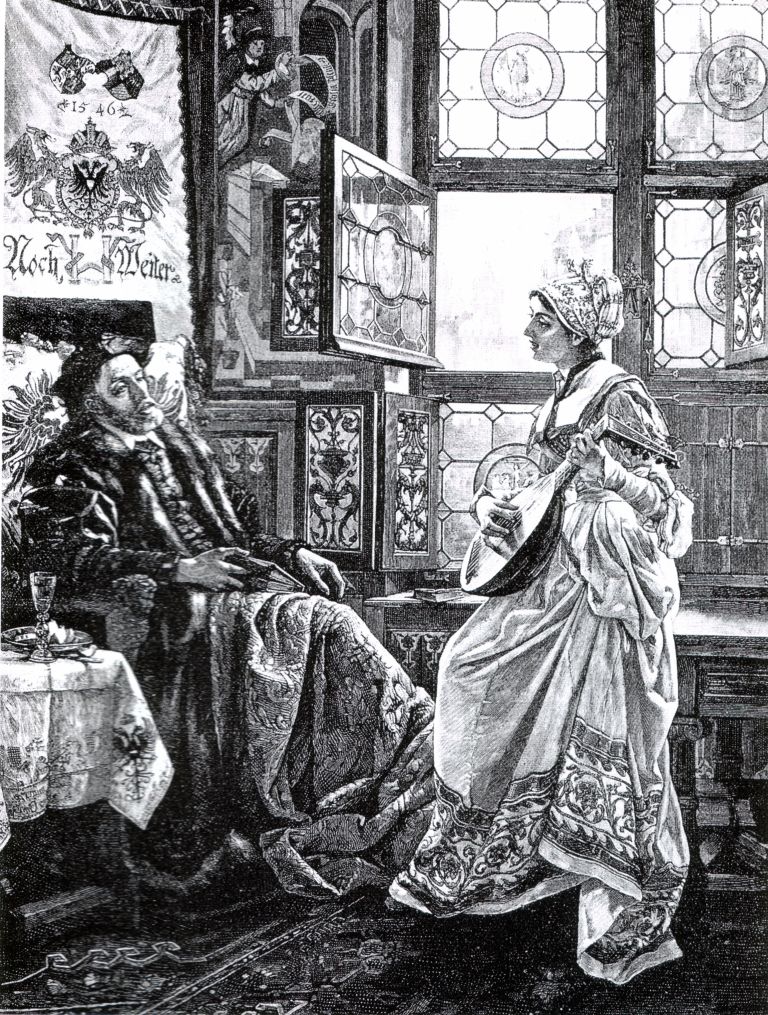 |
| Charles V & Barbara Blomberg @Wikipedia |
1) Barbara Blomberg (1527-1597)
Wife of: Seigneur Rechem, an Imperial official.
Natural offspring:
a. Don Juan de Austria (1547-1578)
" . . . a young lady of quality in Ratisbon, mistress of the emperor Charles V. (Platts: 13)
" . . . This lady belonged to a noble family of Flanders, and was a celebrated beauty of her day. After his love for her was extinct, Charles V gave Barbe de Blomberghe, with a large dowry, in marriage, to a certain Seigneur Rechem, who held considerable possessions in the province of Luxemburg, and lived constantly at Antwerp." (Blackwood's Magazine, Vol. 63: 70)
Affair's benefit.
" . . . Emperor Charles V granted Barbara Blomberg an allowance of 200 gulden and married her to an imperial official with a dowry of 5000 gulden, equivalent to that of a countess." (Hurwich: 208)
" . . . Considerable doubt still hangs around the name and rank of his mother. History has been accustomed to call her Barbara Blomberg, daughter of a noble family at Ratisbon, and unmarried at the time she became a mother. She owed her introduction to the Emperor to her fine voice, and was brought to play and sing to him during one of his visits to Ratisbon, to divert the melancholy under which he long laboured after the death of his Empress Isabella. The personal charms of the musician are said to have tempted him to a closer intimacy, which resulted in the birth of Don John of Austria. The historian Strada, on the other hand, was told by Cardinal de la Cueva that he had himself heard from the lips of the Infanta Arch-Duchess Isabella, the favourite daughter and confidant of Philip II, that her famous uncle was the son, not of his reputed mother, but of a lady of princely pedigree." (Don John of Austria: 2)
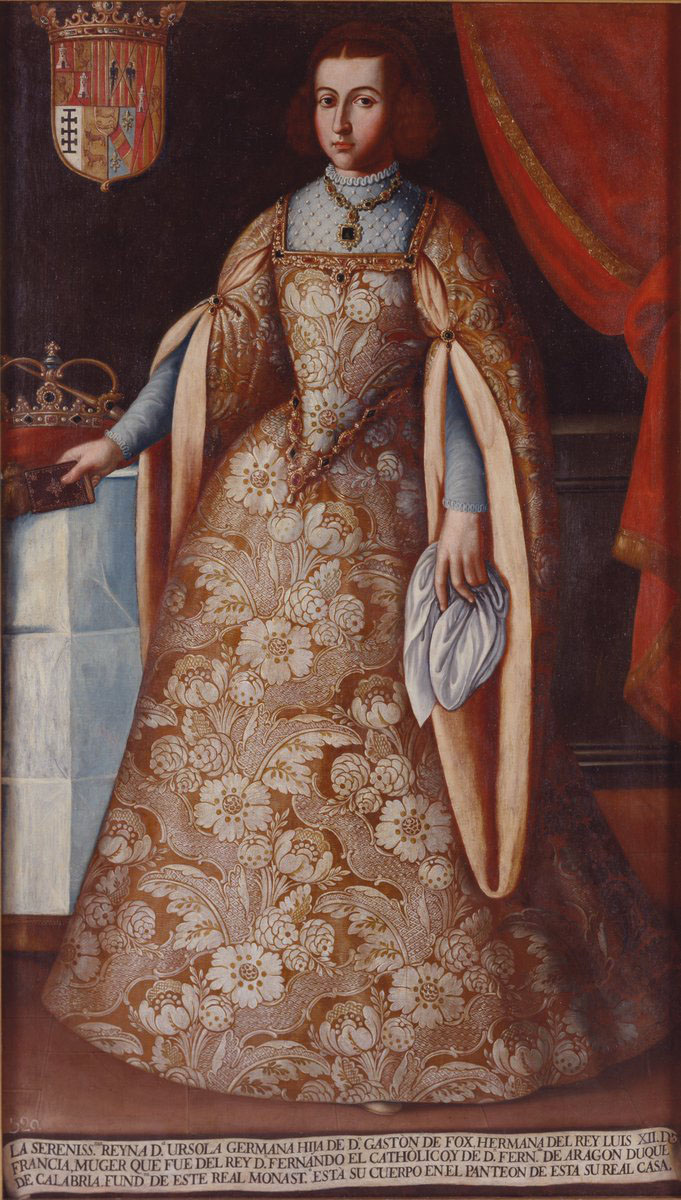 |
| Germaine de Foix |
2) Germaine de Foix (1488-1538)
Dowager Queen of Aragon
Widow of his grandfather Fernando II
Natural offspring:
a. Isabel de Castilla (1518-1536)
"Already in 1522 people talked constantly to Charles of his need to marry. An heir was necessary. It seems possible, however, that he had a mistress in Spain in the surprising shape of Germaine de Foix, the pretty young widow of his grandfather Fernando the Catholic. Had not that grandfather requested in his will that Charles should concern himself with her? The conclusion that there was at least an amitie amoureuse between the two was argued by Melchor Fernandez Alvarez, while Lorenzo Vital recalled that the Emperor had a little wooden bridge made from his lodgings to hers, which enabled him to visit her secretly. . . There is also the possibility that Isabel, daughter of Germaine de Foix, King Fernando's widow, was the child of the Emperor. She was still living in 1536" (The Golden Empire: 37)
Lover in 1521-1522.
Daughter of: Gilles Johan van der Gheynst, a tapestry maker & Johanna van der Caye van Cocambi.
Wife of: Jean van den Dyke (in 1525)
Natural offspring:
1. Margarita de Austria (1522-1586)
"In 1522, after Charles had left Flanders, a girl whom Charles had casually seduced in the Netherlands, Joanna van der Gheest, daughter of a tapestry-maker of Oudenaarde, gave birth to a baby girl, who was recognized by Charles as his daughter. This was the future Margaret of Parma who, having been looked after and educated by her namesake the Archduchess, would thirty years later become Regent in Brussels." (The Golden Empire: 37)
"Shortly before abdicating, the Emperor wrote a codicil dated June 6th, 1554 in which he recognized he had had two illegitimate children: ---Being myself in Belgium, I visited in the small town of Oudenaarde the castle of Charles of Lalaing, Lord of Montigny, who had as servant a very beautiful Flemish young girl, Johanna Mary van der Gheynst, whom I fell in love with and later a baby girl named Margarita was born from her on December 28th, 1522, and she was entrusted to the Douwrin family for her upbringing for a while. At seven, she was legitimized as her great aunt Margarita of Austria, Governor of the Netherlands, decided to care for her education until her death in 1530, the guardianship of the girl was put under my sister Maria of Austria, Queen of Hungary. Pope Clement VII, finding himself surrounded by the turbulent affairs in Italy with the fight of power we had with King Francois I of France, Clement VII at last agreed to sign peace with me, which as part of the agreement I had to accept the reinstatement of the House of Medici---seemingly illegitimate son of Pope with a black maid---in the agreement, as a means of definitively maintaining the loyalty of the Pope, it wa also agreed Alexander's engagement to my daughter Margarita, barely of five years old, it was not until July 5th, 1531 when Alexander de Medici formally entered Florence as sovereign duke, I raised Florence to the rank of hereditary Duchy in April 1532 and Margarita was formally legitimized by me in 1533, taking the name of Margarita of Austria. She would later be by his marriage, Duchess Consort of Florence and Duchess of Parma." (From Al Andalus to Monte Sacro: 124)
4) Ursolina della Penna (1500-1580)
Wife of: Valentin de Cancellieri, Knight of Perusa
Natural offspring:
a. Tadea de Austria (1522-1562), married to Sinibaldo Copeschi di Montefalcone
"Two other girls were apparently born to Charles at his time... second, Tadea, an Italian daughter of Ursolina della Penna, 'the beauty of Perugia' who reached the imperial court at Brussels in 1522... Tadea lived in Rome, being still alive in 1562. (Thomas: 37)
5) Unnamed mistress.
Natural offspring:
Juana de Austria (1522-?), nun in Convent of Our Lady of Grace & Sacred Music
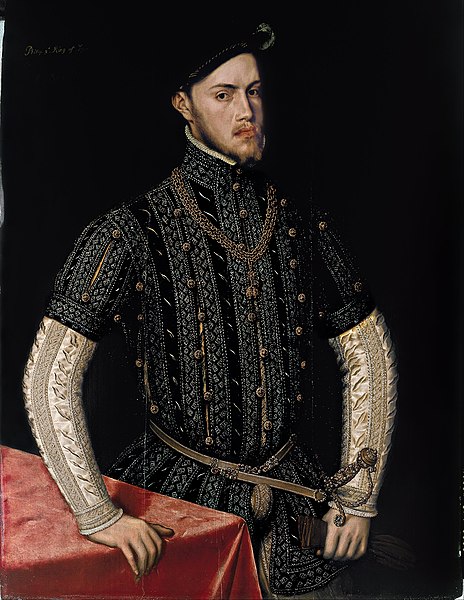 |
| Philip II of Spain @Wikipedia |
His lovers were:
1) Catalina Lainez.
Daughter of: Pedro de Cartagena & Maria de Rojas.
Husband of: Spanish courtier
2) Catherine Leney.
4) Elizabeth Tudor.
Lover in 1559-1564.
Lady-in-waiting to Joana de Portugal, Princesa de Asturias.
[Ref]
Daughter of: Gonzalo de Guzman, Senor de Prejamo, Senor de Villafuerte.
Wife of: Antonio de Leyva, 3rd Principe de Ascoli, Son of Luis de Leyva (d.1560), 2nd Principe de Ascoli. Captain-General of Milan, & Mariana de la Cueva y Bobadilla
Natural offspring:
1. Antonio Luis de Leyva y de Guzman (1527-?)
4th Principe de Ascoli, Marques de Atela.
[Ref]
"Despite marriage, Philip continued to divert his sexual energies elsewhere. From 1559 his lover was Eufrasia de Guzman, a lady-in-waiting of his sister Juana. In 1564 she became pregnant, so he married her off to a court noble, the prince of Ascoli. He may have had other lovers, but they were not documented. In 1563 an ambassador reported that his favourite recreations were hunting, tourneys, and, above all, 'ladies'." (Philip of Spain: 90)
" . . . An incident in August 1564 aggravated these reactions and provoked considerable gossip at court. The king and queen were at a palace window in Madrid with princess Juana, waiting for a big reception to commence. The pregnant queen happened to see Philip's recent mistress, the also pregnant Eufrasia de Guzman, now the princess of Ascoli, coming into the palace for the reception, dressed to kill. Her expression changed, she started to bleed from the nose, and had to be taken out. 'She later sent a message to the king to say she could not go to the reception, and that she was unwell. So the reception was cancelled, though the palace was already full of guests. Elizabeth was seriously ill in bed for three weeks. Philip spent all that first night at her bedside. It may have helped to convince her, though in French circles there was a constant suspicion that the king did not love her. By the end of August she had recovered completely. The illness, however, ended the pregnancy." (Philip of Spain: 203)
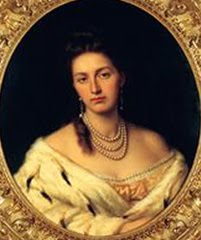 |
| Isabel de Osorio |
6) Isabel de Osorio (1522-1589)
Daughter of Pedro de Cartagena & Maria de Rojas.
Natural offspring: 1. Pedro; 2. Bernardino.
"Philip accepted the marriage with Mary as a purely political move. He was not enthusiastic about it, but deferred to his father's wish absolutely. His agreement was given even before he received a portrait (now also in the Prado), executed by Antonis Mor. In 1553 he was twenty-six years old, eleven years her junior, and had been unmarried for eight years. In contrast to his reserved attitude to his first wife, during these eight years he had built up a reputation for his adventures with ladies. On his grand tour, in Italy, Germany and the Netherlands, he had been a great success with the young women. Mary Tudor pointedly asked Renard about this aspect of the prince. At the very time that the negotiations with her were in progress, Philip in Valladolid was enjoying a relationship with a court lady-in-waiting, Isabel Osorio. It was a serious affair that lasted a few years. He took care of her (she remained unmarried) and she died, wealthy, in 1590. . . ." (Philip of Spain: 54)
" . . . [Prince William of Orange] charged that before marrying Maria of Portugal, Philip had secretly married Isabel de Osorio, by whom he had at least two children. These accusations are almost certainly untrue, ridiculous, in fact, given the boy's age; but they have circulated for so many centuries that they are now established in Philip's biography. . . ." (Philip of Spain: The Forgotten Sovereign: 171)
" . . . There were recurring rumors on this point, one or two involving a lady-in-waiting. Isabel de Osorio, before she died in 1589, claimed that she had been Philip's wife. The court historian who reported her story explained it all by saying that the lady was mentally unbalanced. Much older than Philip, she was assigned to help care for him when he was a little boy. In time she came to live him so much that she began to imagine herself as his wife. . . ." (Philip of Spain: The Forgotten Sovereign: 171)
7) Madeleine Dacre.
" . . . Felipe II had a long-time relationship with doña Isabel de Osorio, before his marriage to Mary Tudor. . . ." (Alexander Palace)
Felipe II's sister (rumour)
"Once married, Philip took his father's advice to heart, though perhaps not in the way it was intended. Far from being uxorious, he was so neglectful of Maria as to cause gossip in the court. Charles thought Philip's problem might just be the bashfulness of an inexperienced teenager, but Philip's mother-in-law felt the boy was cold and thoughtless. Years later Prince William of Orange, involved in open revolt against Philip, said this was certainly not the case. He claimed it was a fact that as a youth Philip had slept with his own sister. . . ." (Philip of Spain, King of England: The Forgotten Sovereign: 25)
9) Viscountess of Montague.
References for Felipe II de España.
hablemos de Felipe II.
 |
| Felipe IV of Spain @El Barroquista |
King of Spain
1621-1665.
Husband of:
The model for Don Juan.
"The king, it was widely believed, was the model for Don Juan, the rake of Seville, as depicted in the seminal play published in 1634 by the friar Gabriel Tellez, whose nom de plume was Tirso de Molina (though the true model for Don Juan could also have been another libertine, Don Miguel de Mañara, known for his seduction of cloistered nuns).
The most lascivious of the Spanish Habsburgs.
"The king professed a fanatical devotion to his Catholic faith, yet there was also a darker side to his character. Felipe IV was the most lascivious of the Spanish Habsburgs and his sexual appetite was nearly inexhaustible. In the days of Olivares, the count-duke was near widely rumoured to be acting as royal procurer of Madrid's nubile damsels. 'The sovereign was given to late-night escapades, in disguise, through the streets of Madrid, frequenting theatres and taverns in search of a tender flesh.' It was in one of these outdoor theatres that Felipe encountered his most celebrated mistress, Maria Calderon, who months after their first encounter presented the monarch with an illegitimate son, Juan Jose de Austria. His mother retreated to a convent after his birth, but the boy was well looked after by his father, who saw to it that he was appointed a general in the Spanish army, and rose to become a popular figure in his own right. There are copious accounts of Felipe's nocturnal escapades in the heart of Madrid. The king was a frequent visitor to a house in Puerta Cerrada, near the Plaza Mayor, where on one occasion he was discovered in flagrante with one of his favourites, known only as Dona Laura, by a passing magistrate. The woman was said to have kept a portrait of the monarch on her bedroom wall and when the magistrate peeped in through the curtains he exclaimed, 'A true likeness. God keep your royal person' -- after which he made a discreet departure." (Madrid: The History: 63)
An automaton of the boudoir.
" . . . All three authorities were -- although in different ways -- wholly disgusted with Philip's alleged promiscuity. To Martin Hume this suggested a man who was a miserable slave of his own passions, a kind of automaton of the boudoir, spending his nights alternately in routine fornication and sleepless remorse. The absolute degeneration in the moral -- and perhaps physical -- fibre of king and court in the last analysis utterly undermined their capacity and fitness to rule the Monarchy. . . ." (Philip IV the the Government of Spain, 1621-1665: 327)
Impossibility of establishing the number of Felipe's infidelities.
"Just as we can never know the truth of this affair, so it remains impossible to establish the number of Philip's infidelities and their genealogical consequences. Hume's casual attribution of 'thirty and more' bastards to him represents a baseless exaggeration of an already absurd legend. Deveze says (in my opinion rightly) that in contrast to the twenty fitzroys customarily present in published accounts, no more than five can be attested from attested from contemporary sources. Such sources also indicate, by an absence of reference which corroborates what we know of the king's mind and behaviour, that Philip's adventures came to an end some time after he made the acquaintance of Sor Maria, and certainly after his second marriage in 1649. Furthermore, the 'institutionalised' royal mistress never became a feature of the court and its politics, as it did (for example) in that of many representatives of the Valois and Bourbon dynasties." (Philip IV and the Government of Spain, 1621-1665: 330)
Felipe IV's choice of women.
"It is curious how in the choice he made of women, there was no distinction of any social class. Another feature of Philip IV was the short duration of their relationships. Among her lovers we can contemplate all kinds of women: married, widowed, single, maidens, ladies of the high nobility, nuns and actresses." (Nueva Tribuna)
 |
Felipe IV of Spain |
His lovers were:
1) Ana Maria de Uribeondo (1620-1703)
Natural offspring:
a. Fernando Valdes y de Uribeondo (1638-1702)
Governor of Novara 1661, mar 1660 Ana Maria di Capece (1642-1685).
Mayordoma of ladies in waiting to Archduchess Mariana de Austria.
Natural offspring:
a. Carlos Fernando de Austria (1639-?)
Canon of Guadix Cathedral.
3) Constanza de Ribera y Orozco.
Lover in 1630-1631
Lady-in-waiting to Elisabeth of France, Queen of Spain
Wife of José Enríquez de Guzmán y Porres, gentleman of the king's chamber
"Friar Alonso de Santo Tomás (1631–1692), born as Alonso Enríquez de Guzmán y de Orozco, was an illegitimate son of King Philip IV of Spain with Constanza de Ribera y Orozco, a lady-in-waiting of Queen Élisabeth of France, who was rapidly married to José Enríquez de Guzmán, gentleman-in-waiting of the King. Alonso became an orphan at the age of 3, and was raised by his adoptive father’s brother, Antonio Enríquez de Guzmán y de Porres, Bishop of Málaga and later Viceroy of Aragón." (Spanish Baroque Art)
 |
Alonso Enríquez de Guzmán |
Bishop of Malaga.
a.k.a. Fray Alonso de Santo Tomas.
"Alonso Henríquez de Santo Tomás of 1631, fruit of the relationship with Constanza de Ribera and Orozco, who was maid of honor of Queen Isabel de Borbón. He was recognized by the husband of Constanza as his son and rejected the recognition of paternity of Felipe IV. He became bishop of Malaga." (Nueva Tribuna)
 |
| Ines de Calderon @Cosas de los Madriles |
Lover in 1627-1642.
Spanish theatre actress.
Royal love at first sight.
" . . . It was a the Corral de la Cruz in 1627 that Philip first set eyes upon the girl whom one of Olivares' agents had sent from the country to act upon the Madrid stage. He name was Maria Calderon, and at the time she appeared in the capital she was not more than sixteen years of age. She was no great beauty, but her grace and her fascination were supreme, and her voice was so sweet and her speech so captivating that Madrid fell in love with her at once. The King from his aposento was enamoured of her the first time he saw her, and for him to desire was to enjoy. . . ." (The Court of Philip IV)
Ines 'la Calderona'
" . . . Even more notable is the case of the celebrated Ines de Calderon, La Calderona, who became the mistress of Philip IV and the mother of Don Juan de Austria. She continued to perform in Valencia while pregnant but as soon as she gave birth the King put her in a convent where she rose to become Abbess - a singular success story by the standards of the day. Her sister Maria, on the other hand, a celebrated actress in her own right, died in poverty, 'miserablemente', in spite of her connections. . . ." (Rhetoric and Reality in Early Modern Spain: 79)
Abandoned & adopted by a great poet.
"One of the best-known loves of Felipe IV was a young actress named María Inés Calderón whom they called 'la Calderona', who was the adopted daughter of the poet and playwright Pedro Calderón de la Barca .The young woman was abandoned as a baby at the door of the house of Calderón, who took care of her and educated her." (Cosas de los Madriles)
Affair's end & aftermath.
"At that time, she had a relationship with Ramiro Pérez de Guzmán, Duke of Medina de las Torres, a widower after the daughter of the Duke of Olivares, who was Spain's real regent. Her relationship with the monarch forced her to retire during a promising career. Controversy erupted with the queen when the king gave her a palace to celebrate. On April 7, 1629, her son was born with the monarch; he was taken away from her despite her protests and came to a foster family. There was a rumor that in reality he was the son of the Duke of Medina de las Torres, but he was recognized in 1642 by the king. Her relationship with the king ceased the same year. In March 1642, Maria Calderon was forced against her will to enter the monastery of San Juan Bautista in Guadalajara. She was abbess 1643-1646." (Wikipedia)
Ines 'la Calderona'
" . . . Even more notable is the case of the celebrated Ines de Calderon, La Calderona, who became the mistress of Philip IV and the mother of Don Juan de Austria. She continued to perform in Valencia while pregnant but as soon as she gave birth the King put her in a convent where she rose to become Abbess - a singular success story by the standards of the day. Her sister Maria, on the other hand, a celebrated actress in her own right, died in poverty, 'miserablemente', in spite of her connections. . . ." (Rhetoric and Reality in Early Modern Spain: 79)
Abandoned & adopted by a great poet.
"One of the best-known loves of Felipe IV was a young actress named María Inés Calderón whom they called 'la Calderona', who was the adopted daughter of the poet and playwright Pedro Calderón de la Barca .The young woman was abandoned as a baby at the door of the house of Calderón, who took care of her and educated her." (Cosas de los Madriles)
Affair's end & aftermath.
"At that time, she had a relationship with Ramiro Pérez de Guzmán, Duke of Medina de las Torres, a widower after the daughter of the Duke of Olivares, who was Spain's real regent. Her relationship with the monarch forced her to retire during a promising career. Controversy erupted with the queen when the king gave her a palace to celebrate. On April 7, 1629, her son was born with the monarch; he was taken away from her despite her protests and came to a foster family. There was a rumor that in reality he was the son of the Duke of Medina de las Torres, but he was recognized in 1642 by the king. Her relationship with the king ceased the same year. In March 1642, Maria Calderon was forced against her will to enter the monastery of San Juan Bautista in Guadalajara. She was abbess 1643-1646." (Wikipedia)
Her other lover was:
Ramiro Núñez de Guzmán, Duque de Medina de la Torres.
"In addition to [his] marriages, Ramiro had numerous amorous escapades, among which include those with the actress María Inés Calderón known as La Calderona, mother of Juan José de Austria and who, due to their physical resemblance, the gossips attributed their paternity." (Wikipedia)
" . . . One of the rumors of the time said that the king had banished the Duke of Medina de las Torres, whom he saw as a rival to the young actress, who happened to be his 'favorite'." (Cosas de los Madriles)
"In addition to [his] marriages, Ramiro had numerous amorous escapades, among which include those with the actress María Inés Calderón known as La Calderona, mother of Juan José de Austria and who, due to their physical resemblance, the gossips attributed their paternity." (Wikipedia)
" . . . One of the rumors of the time said that the king had banished the Duke of Medina de las Torres, whom he saw as a rival to the young actress, who happened to be his 'favorite'." (Cosas de los Madriles)
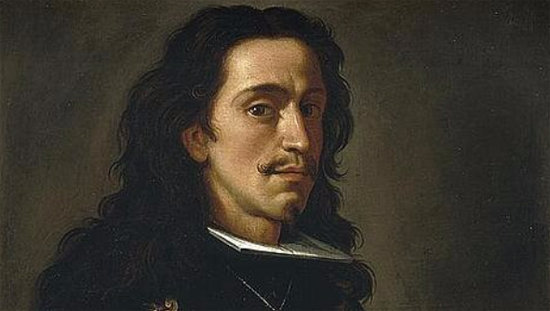 |
| Don Juan de Austria the Younger |
Natural offspring:
a. Juan Jose de Austria. (1629-1679)
Viceroy of Cataluña, Viceroy of Naples, Governor-General of the Netherlands.
Mother of the 2nd Don Juan of Austria.
" . . . A decade later still, Philip's most celebrated mistress, the actress Ines de Calderon, gave birth to a boy, to whom Philip, regarding the child as his own, gave the names of Juan Jose. The love-child who was to be the second Don Juan de Austria was named thus in what we may assumed was a pious -- or, at any rate, respectful -- imitation of Philip's venerated great-grandfather, Charles V." (Philip IV the the Government of Spain, 1621-1665: 328)
5) Juana Calderon.
6) Laura.
"It was easier for the king to conquer a beautiful lady named Laura, who had been widowed a short time ago. She lived in the Plaza de Puerta Cerrada and there Felipe IV went incognito to visit her, and he was reciprocated by her. Since the extramarital relations were condemned by law, the float that frequented the house of the widow raised the suspicions of the lieutenant-corregidor of House and Court, Ramiro de Vozmediano, who one day entered the house and found the widow alone, but He noticed the movement of the curtains in his bedroom and asked the lady behind him, and she replied: "A portrait of his majesty, is so alive that, perhaps, his contemplation could damage the health of your lordship." Not satisfied, the corregidor drew back the curtains and seeing the king in front said: "In truth, I've never seen such a similar portrait". He bowed and left quickly." (Cosas de los Madriles)
7) Margarita de Escala (1625-1699)
Natural offspring:
a. Ana Margarita de Austria. (1641-1699), Nun 1656
8) Maria de Chirel (1607-1626)
a.k.a. Maria Chivel?.
Natural offspring:
a. Francisco Fernando Isidro de Austria (1626-1634)
"Apparently he was the first illegitimate son of the king, of his first extra-conjugal romance with the daughter of the Count of Chirel, with whom he began to relate before the age of twenty. Perhaps for that reason he was very fond of the child. Felipe IV had many advantages to be able to get lovers: he sent the father on a mission to Italy to be able to access the daughter without a father's interposition. The boy died when he was eight years old and his mother died shortly after. The house where they lived was razed to build on their lot the convent of the "Concepción Real", a game of words that gave many jokes at the time. The convent still exists , today in Calle de Alcalá. Francisco Fernando was recognized as a legitimate son after his death - when he was no longer a threat to the crown - and is buried in the Pantheon of Infants of El Escorial." (El Barroquista)
9) Mariana Perez de Cuevas.
Natural offspring:
a. Alonso Antonio de San Martin (1636-1705)
Bishop of Oviedo 1656, Bishop of Cuenca 1664.
10) Teresa Aldana (1620-1664)
Sister of Tomasa Aldana.
Natural offspring:
a. Juan Cosio del Sacramento (1640-1701), Augustinian monk 1655, a.k.a. Juan Cosio de Austria.
"There is some confusion about the identity of his mother, but in any case it must be a lady of the Court. He was born in Ciudad Real and was raised by one Francisco Cossío, from whom he took the surname. Although this last name did not serve to hide the suspicion of who his father really was. With 15 years he entered as a religious in the Order of St. Augustine and soon moved to Naples, where he made a career as a notable preacher, arriving to publish an influential biography of St. Vincent de Paul . As Father Flórez testified , everyone in the city knew whose son he was. This is how the situation relates when Carlos II, the heir of Felipe IV, reigned: "When seeing him on the street, some used to say without caution: There goes the brother of the King, (who was Carlos II) as he heard a Religious, whom I tried.'" (El Barroquista)
11) Tomasa Aldana (1617-1676)
Sister of Teresa Aldana.
Natural offspring:
a. Alfonso Enriquez de Santo Tomas (1634-1692), Bishop of Osma 1653, Bishop of Plasencia 1657, Bishop of Malaga 1664.
12) Unnamed mistress from Calahorra.
Natural offspring:
a. Domingo de San Cristobal (1631-1683), Augustinian monk 1649.
13) Unnamed mistress from Madrid.
Natural offspring:
a. Margarita de Austria (1625-1650), Nun in Descalzas Reales Convent 1641.
14) Unnamed mistress
Natural offspring:
a. Carlos.
 |
Carlos II of Spain |
(1661-1700)
King of Spain
1665-1700.
Son of: Felipe V de España & Mariana von Osterreich.
Husband of:
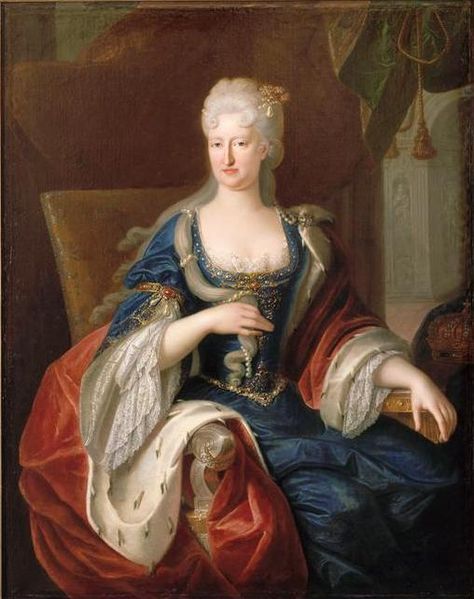 |
| Marianna of Neuburg @Wikipedia |
"Maria Anna of Neuburg, born in Dusseldorf, Germany, was selected among several candidates because of the fertility of her family, since her mother had given birth to twenty-three sons. Moreover, Eleonore Magdalene---Maria Anna's eldest sister who had ten---was married to Emperor Leopold I, which strengthened the links with Austria. Maria Anna arrived in Spain in 1690, getting married to Charles II on the 14th of May of that same year. The wedding was celebrated in the church of San Diego's convent, within the ensemble of Valladolid Royal Palace. Although Charles II wanted to personally oversee the last years of his reign, his manifest incapacity would not allow him. His health conditions were really precarious, due to a general exhaustion which prevented him to be able to stand upright without leaning on a wall, on a table, or on somebody. His only pastime was walking to the Palace bakery to eat pastries. He put the power in the hands of his spouse; of an unknown Prime Minister Enriquez de Cabrera---Queen's lover---which took counsel with Cardinal with Cardinal Luis Manuel Fernandez de Portocarrero, archbishop of Toledo and King Charles II's state counsellor. Given the King's incapacity to have children, the Court got tangled up in intrigues, having the Monarch believe that the cause of his sterility was the Queen and her lover Enriquez who had cast a spell on him. Naive Charles II underwent all kinds of exorcisms to get rid of the demon haunting his body. All this witchcraft almost put an end to his life." (From Al-Andalus to Monte Sacro: 249)
Marianna von Neuburg's lover.
Enriquez de Cabrera
Prime Minister.
 |
| Felipe V of Spain |
(1683-1746)
King of Spain
1700-1746
 |
| Fernando VII of Spain @Wikipedia |
Husband of:
1. Maria Antonia di Due Sicilie, mar 1802, died 180
2. Maria Isabel de Portugal, mar 1816, died 1818
3. Maria Josepha Amalia von Sachsen, mar 1819, died 1829
4. Maria Christina di Due Sicilie, mar 1829.
His lovers were:
1) Maria Antonia Perez.
Madrid prostitute.
2) Pepa La Malaguena.
Queen Maria Cristina's 2nd husband:
Madrid Brothel owner.
Queen Maria Cristina's 2nd husband:
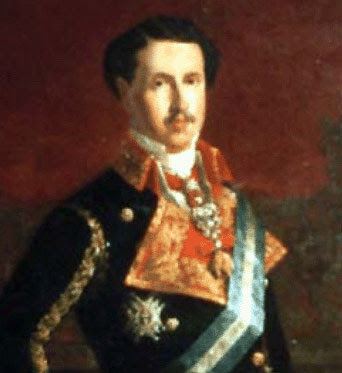 |
| Agustin Muñoz Duque de Riansares @Alchetron |
Agustin Fernando Muñoz y Sanchez (1808-1873)
1st Duke of Riansares
1st Duke of Montenegro
1st Marques of San Agustin
Grandee of Spain.
Son of: Juan Antonio Muñoz, 1st Conde de Retamoso, 1st Vizconde di Saviñan & Eusebia Sanchez.
Son of: Juan Antonio Muñoz, 1st Conde de Retamoso, 1st Vizconde di Saviñan & Eusebia Sanchez.
| Jose of Spain |
 |
| Annette Savage |
Daughter of: John Savage of Philadelphia, USA
& Margaret Larkey.
Wife of:
1. Charles Joseph Gellhand Delafolie
2. Henry Horr.
" . . . Sometime in 1839 when Joseph Bonaparte took a trip back to England, he provided a home for his American 'wife' (Annette Savage who later married Joseph de la Foille and after he died she married Harry Horr, at which point they moved to New York City) and daughter by building a home on a bend of the Indian River between Evans Mills and Philadelphia. Later Julie, a daughter by this marriage, married a local." (Jefferson County)
"Since Bonaparte's wife did not accompany him to America (he did not see her for 25 years after he left), another frequent guest at the house was his mistress, Annette Savage. Bonaparte had met Annette, the 18-year-old, French-speaking daughter of distinguished Virginia merchants, while he was shopping for suspenders at her mother's shop in Philadelphia. During their time together, Bonaparte and Annette would have two daughters, Caroline Charlotte and Pauline Josephe Anne." (cnn.com:Napoleon's Brother)
" . . . Joseph Bonaparte, former king of Spain, lived in nearby Bordentown in 1816. He kept a beautiful Quaker mistress, Annette Savage, in a mansion nb Lalor Street in Trenton, while his wife, the former queen, lived far away in Spain. Annette was shunned by society in Trenton, and had a rather lonely existence. Her life became even more unbearable after her daughter Pauline died. Shortly after Pauline's burial at St. Michael's, Joseph Bonaparte took Annette and their other daughter, Charlotte, to upstate New York, where he had a house built for his mistress near Watertown. Bonaparte eventually returned to his wife in Spain, and Annette married a young Frenchman. The relationship of Annette Savage and Joseph Bonaparte later was recognized when Charlotte was presented in court to Napoleon III." (Old Burial Grounds of New Jersey: A Guide: 116)
2) Elisabeth Dozolle.
 |
| Emilie Hemart |
3) Emilie Hemart (1798-1879)
Daughter of: Claude-Nicolas-Louis Hemart & Amelie-Francoise Doberseq
Wife of:
1. Felix Lacoste (1795-1853), mar 1819
2. Louis Edmond Anthoine.
Natural offspring:
a. Felix-Joseph Lacoste (1825-1922)
4) Maria del Pilar Acedo, Marquesa de Montehermoso (1784-1869)
5) Maria Giulia Colonna (1783-1867)
Duchessa d'Atri
Daughter of Andrea Colonna di Stigliano, Principe di Stigliano & Cecilia Ruffo.
Wife of: Giangirolamo Acquaviva d'Aragona, 23rd Duca d'Atri (1786-?), mar 1804
" . . . The French charge d'affaires, D'Aubusson de la Feuillette, later reported to Paris in scandalized terms that Joseph's lover, Maria Giulia Colonna, Duchess of Atri---who bore him two children---had been given a gift of 5,000 ducats. . . ." (Davis. Naples and Napoleon: 144)
6) Teresa de Montalvo, Condesa de Jaruco
" . . . Pignatelli soon discovered that Roederer had left no accounts, and that before leaving for Madrid Joseph had made generous settlements in favour of his ministers, favourites, and mistresses. The French charge d'affaires, D'Aubusson de la Feuillette, later reported to Paris in scandalized terms that Joseph's lover, Maria Giulia Colonna, Duchess of Atri -- who bore him two children -- had been given a gift of 5,000 ducats. . . ." (Davis: 144)
"An interesting story is behind this lonely monument: Pauline Joseph Ann Holton was Napoleon Bonaparte's niece. His brother, Joseph Bonaparte, former king of Spain, lived in nearby Bordentown in 1816. He kept a beautiful Quaker mistress, Annette Savage, in a mansion on Lalor Street in Trenton, while his wife, the former queen, lived far away in Spain. Annette was shunned by society in Trenton, and had a rather lonely existence. Her life became even more unbearable after her daughter Pauline died. Shortly after Pauline's burial at St. Michael's, Joseph Bonaparte took Annette and their other daughter, Charlotte, to upstate New York, where he had a house built for his mistress near Watertown. Bonaparte eventually returned home to his wife in Spain, and Annette married a young Frenchman. The relationship of Annette Savage and Joseph Bonaparte later was recognized when Charlotte was presented in court to Napoleon III." (Sarapin: 116)
King of Spain 1874-1885
Son of:
Isabel II de Espana & Francisco de Asis de Borbon, Duke of Cadiz.
The promiscuous king.
"At the end of the nineteenth century, Spain was ruled by another Bourbon in the person of the promiscuous King Alphonso XII, who life was brought to a premature end in 1885 when he was only twenty-eight years old. Officially he died from consumption, but there was little doubt that the real cause of death was venereal disease. At the age of seventeen, Alphonso had fallen in love with the beautiful Princess Mercedes, daughter of the Duke of Montpensier. Although his bride was also his first cousin it was a rare love match. Within six months of their wedding day, however, she was struck down dead with gastric fever. As she was also related to the unfortunate Austrian Emperor Franz Joseph, superstitious Spaniards blamed her death on the so-called Habsburg Curse. Alphonso plunged into an almost suicidal depression from which he never quite recovered. He regained his poise sufficiently to honor his dynastic obligations, and a year later was remarried to Maria, daughter of the star-crossed Archduke Franz Ferdinand. In private, however, he submerged his grief in the beds of other women." (Royal Babylon: The Alarming History of European Royalty: 113)
"The darker side to Alfonso's character became prominent after Mercedes's death. Unlike tales of his soldierly valour, this remained a topic of quiet cafe speculation. To his sobriquets of 'Pacifier' and 'Gallant' could have been added that of Alfonso the Promiscuous. A living Madrid restaurateur relates the story of a walled-up tunnel in his wine cellar, which is believed to connect to the Palacio Real. It is said that Alfonso, who was known to have a close relationship with the opera singer Elena Sanz, availed himself of this tunnel to dine in seclusion with his mistress. One of the most colourful incidents in the king's extracurricular life took place when Alfonso, ensconced in his thick black cape, was returning from one of his frequent nocturnal ambulations around the streets of old Madrid. He had lost his way and ran across a sereno, or nightwatchman, on his rounds. The king asked for Calle de Bailen, which leads to the palace. The sereno offered to show this obviously respectable gentleman the way and a short stroll brought them to the palace gates, when the king turned and said, 'Many thanks, my friend. If I can ever be of assistance, just ask for Alfonso XII.' To which the sereno replied, 'Of course, and I'm Pope Pius IX, if ever you need anything from the Vatican." (Madrid: The History: 136)
"By contracting an arranged marriage King Alfonso XII may not have expected to find happiness with his second wife that he had enjoyed with the first, but it was only as everybody had foreseen. Much to Queen Maria Cristina's mortification, he proved himself only too ready to look beyond his wedding ring for distractions and pleasures. Ever since he had returned to Spain from exile, mistresses had been smuggled into the palace, and when necessary he was equally ready to leave the palace quietly in order to visit them. Not long after his accession he had had a brief affair with Adelina Borghi, an opera singer. His relationship with another singer, Elena Sanz, proved more durable, and she bore him two sons, Ferdinand and Alfonso. Elena was about thirteen years older than Alfonso, and he had known her since 1872 as her career had been partly sponsored by Queen Isabel, and she had sung at the former Queen's palace in Paris. His unflattering comparisons between singing and the howling of a dog evidently counted for little when he sought his pleasures of the flesh." (Divided Kingdom)
Great secret royal scandal of the 19th century.
"The darker side to Alfonso's character became prominent after Mercedes's death. Unlike tales of his soldierly valour, this remained a topic of quiet cafe speculation. To his sobriquets of 'Pacifier' and 'Gallant' could have been added that of Alfonso the Promiscuous. A living Madrid restaurateur relates the story of a walled-up tunnel in his wine cellar, which is believed to connect to the Palacio Real. It is said that Alfonso, who was known to have a close relationship with the opera singer Elena Sanz, availed himself of this tunnel to dine in seclusion with his mistress. One of the most colourful incidents in the king's extracurricular life took place when Alfonso, ensconced in his thick black cape, was returning from one of his frequent nocturnal ambulations around the streets of old Madrid. He had lost his way and ran across a sereno, or nightwatchman, on his rounds. The king asked for Calle de Bailen, which leads to the palace. The sereno offered to show this obviously respectable gentleman the way and a short stroll brought them to the palace gates, when the king turned and said, 'Many thanks, my friend. If I can ever be of assistance, just ask for Alfonso XII.' To which the sereno replied, 'Of course, and I'm Pope Pius IX, if ever you need anything from the Vatican." (Madrid: The History: 136)
"By contracting an arranged marriage King Alfonso XII may not have expected to find happiness with his second wife that he had enjoyed with the first, but it was only as everybody had foreseen. Much to Queen Maria Cristina's mortification, he proved himself only too ready to look beyond his wedding ring for distractions and pleasures. Ever since he had returned to Spain from exile, mistresses had been smuggled into the palace, and when necessary he was equally ready to leave the palace quietly in order to visit them. Not long after his accession he had had a brief affair with Adelina Borghi, an opera singer. His relationship with another singer, Elena Sanz, proved more durable, and she bore him two sons, Ferdinand and Alfonso. Elena was about thirteen years older than Alfonso, and he had known her since 1872 as her career had been partly sponsored by Queen Isabel, and she had sung at the former Queen's palace in Paris. His unflattering comparisons between singing and the howling of a dog evidently counted for little when he sought his pleasures of the flesh." (Divided Kingdom)
Great secret royal scandal of the 19th century.
"The King's philandering produced one of the great secret royal scandals of the nineteenth century. One of Alphonso's regular mistresses was the wife of a young army officer. The King discovered, to his irritation, that the husband was a jealous and naturally suspicious type, and so he pulled a few strings to put him permanently out of the picture. The cuckolded young officer suddenly found himself dispatched to Cuba on a series of dangerous and life-threatening assignments. Inconveniently for King Alphonso XII, the young officer survived. Worse still, someone had tipped him off as to the real reason he had been posted 3,000 miles from Madrid. He deserted and returned home. When the King next arrived at his mistresses's house, he found her husband armed and waiting, intent on revenge. This time, however, Alphonso had taken the precaution of bringing along an armed bodyguard. The jealous husband was put to the sword and his body secretly disposed of." (Royal Babylon: 113)
The Gallant King.
The King has a redeeming side to him, too."Alfonso's reign was brief, but unlike the regency that was to follow his death, far from uneventful. The Sandhurst cadet led his army in the campaign to eradicate the last vestiges of Carlist resistance, for which he became known as 'el Pacificador' ('the Pacifist). Shortly after putting down a Carlist rebellion in the Basque Country, in October 1878 the king attended a service at the Atocha basilica to celebrate his safe return to Madrid. As he rode on his horse to the palace along the Calle Mayor, an anarchist leapt out of the crowd and fired two shots at the king. He missed, and from that day Madrileños added 'el Galan' ('the Gallant') to the king's titles." (Madrid: The History: 136)
The Gallant King.
The King has a redeeming side to him, too."Alfonso's reign was brief, but unlike the regency that was to follow his death, far from uneventful. The Sandhurst cadet led his army in the campaign to eradicate the last vestiges of Carlist resistance, for which he became known as 'el Pacificador' ('the Pacifist). Shortly after putting down a Carlist rebellion in the Basque Country, in October 1878 the king attended a service at the Atocha basilica to celebrate his safe return to Madrid. As he rode on his horse to the palace along the Calle Mayor, an anarchist leapt out of the crowd and fired two shots at the king. He missed, and from that day Madrileños added 'el Galan' ('the Gallant') to the king's titles." (Madrid: The History: 136)
 |
| Maria de las Mercedes de Orleans @Wikipedia |
Husband of:
1. María de las Mercedes de Orleans (1860-1878), mar 1878
 |
2. María Cristina de Habsburgo-Lorena (1879-1885)
"'We have a charming sister-in-law who I am sure is going to make Alfonso happy again,' Paz wrote. As a personality, Queen Maria Cristina lacked the spontaneity and charm of her husband's first wife. She was a foreigner, and many of the Spaniards found her too correct, too detached and too controlled. Queen Mercedes, they said, had never let anyone forget that she was a woman, while Queen Maria Cristina never let them forget that she was Queen. Nevertheless she soon gained the respect of her husband's subjects. She might appear reticent and frigid, in severe contrast to her predecessor but she was calm, tactful and had a strong sense of duty." (Divided Kingdom)
"'We have a charming sister-in-law who I am sure is going to make Alfonso happy again,' Paz wrote. As a personality, Queen Maria Cristina lacked the spontaneity and charm of her husband's first wife. She was a foreigner, and many of the Spaniards found her too correct, too detached and too controlled. Queen Mercedes, they said, had never let anyone forget that she was a woman, while Queen Maria Cristina never let them forget that she was Queen. Nevertheless she soon gained the respect of her husband's subjects. She might appear reticent and frigid, in severe contrast to her predecessor but she was calm, tactful and had a strong sense of duty." (Divided Kingdom)
Close relationship before king's death.
"Alfonso was genuinely fond of his second wife, but he was under no illusion that the marriage to Maria Cristina was gong to be anything other than one of political expediency. Their relationship came under acute strain from the start, due to the king's increasingly frequent extramarital escapades. Maria Cristina's shrill voice was often heard from the royal bedchamber late at night, reprimanding her wayward husband. But the couple drew closer towards the end of their married life, the queen no doubt sensing that her husband was not destined to enjoy an old age. Alfonso never got over the loss of Mercedes, and his despair contributed to a weakened physical state and eventually a severe chest infection, believed to have been brought on by tuberculosis, which on 25 November 1885, three days short of the king's 28th birthday, put an end to his life. The following day, Madrid's church bells sounded a dirge in every quarter of an hour throughout the day, and the guns of the army garrison fired salvos from morning to sunset. Maria Cristina, who was three months pregnant at the time, pasted some dried leaves into her diary that morning, with an inscription in German in the margin which reads: 'From the branch I gave to my Alfonso in our residence of [the French resort of] Arcachon, 22 August 1870.'" (Madrid: The History: 137)
"Alfonso was genuinely fond of his second wife, but he was under no illusion that the marriage to Maria Cristina was gong to be anything other than one of political expediency. Their relationship came under acute strain from the start, due to the king's increasingly frequent extramarital escapades. Maria Cristina's shrill voice was often heard from the royal bedchamber late at night, reprimanding her wayward husband. But the couple drew closer towards the end of their married life, the queen no doubt sensing that her husband was not destined to enjoy an old age. Alfonso never got over the loss of Mercedes, and his despair contributed to a weakened physical state and eventually a severe chest infection, believed to have been brought on by tuberculosis, which on 25 November 1885, three days short of the king's 28th birthday, put an end to his life. The following day, Madrid's church bells sounded a dirge in every quarter of an hour throughout the day, and the guns of the army garrison fired salvos from morning to sunset. Maria Cristina, who was three months pregnant at the time, pasted some dried leaves into her diary that morning, with an inscription in German in the margin which reads: 'From the branch I gave to my Alfonso in our residence of [the French resort of] Arcachon, 22 August 1870.'" (Madrid: The History: 137)
Alfonso XII's lovers were:
1) Blanca Espronceda de Escosura (1834-1900).
"Daughter of the poet José de Espronceda and Teresa Mancha, born in Madrid on May 11, 1834. Her childhood was marked by maternal neglect, every time that, at the end of 1836, Teresa abandoned both, fed up with the life of conspiracies of the poet and movida, ultimately, by the participation of Espronceda in the mutiny of the farm in the summer of 1836, amen of being persuaded that the concealment of Espronceda had more to do with Affairs of skirts than with real political conspiracies. Such abandonment occurred twice: the first to flee with a student to Valladolid, where Espronceda was to look for it, and the second, final, already mentioned at the end of 1836. Her wedding with Narciso de la Escosura, a friend of his father and brother of the poet Patricio de la Escosura also continue within literary environments. His main work in this field was the publication, in 1884, an edition of the works of his father who was "enriched with several new productions were found between the autograph of the author" and which should consist of two volumes, of which the second, intended for works in prose and dramatic, did not see the light. Despite the bombastic announcement and appear sponsored by the daughter of the poet and Patricio de la Escosura, personal friend of the same, it is a very careless editing that is still, basically, two previous editions: the Paris of 1867 and a volume of forgotten pages published in Madrid in 1873 that Escosura added some handwritten poems which retained autographs. Despite its shortcomings, this edition became the basis of all subsequent including those carried out by Moreno Villa and Domenchina in the first third of this century, until you reach the de Robert Marrast in 1969." (Biography of Blanca Espronceda de Escosura (1834-ca.1900))
2) Adela Aymerich (1854-1920)
Natural offspring:
a. Adelina.
3) Adelina Borghi (1826-1901)
Lover in 1875-1885
Italian opera singer @ Royal Theatre.
 |
| Adela Borghi @Doce Linajes |
Lover in 1875-1885
Italian opera singer @ Royal Theatre.
"Meanwhile, Alfonso XII's relations with Elena Sanz went off, due to the separation of both. But the King, soon found comfort, to infatiate this time, paradoxes of life, with another opera singer, who was none other than our Adela Borghi. It seems that he saw her for the first time at the Teatro Real in Madrid, in 1875, when she played the role of a page in the opera “Los Hugonotes” by composer Giacomo Meyerbeer and libretto by Eugene Write and soon they were already lovers, even, maybe, that same night." (Doce Linajes)
"Feeling humiliated with such an attitude of the singer and the behavior of her royal husband, in January 1877, she addressed the President of the Government, in the terms in which we headed this article. With no other remedy left to Don Antonio and to avoid greater evils, knowing that he would be very angry at the monarch, he called the governor of Madrid, who was at the time, Jesus Elduayen, and who later, without being at fault, almost caused a crisis of government. Once in his presence he ordered him to appear at the singer's home with the order to leave Spain immediately. This was done by the governor, who, breaking into his house told him to prepare his luggage, and guarded by two policemen, drove her to the North Station, where they took the first train to Irun and left it on the border with France. At the same time they informed the embassies and consulates of Spain in France and Italy, that they had been expelled as a “non grata” person. But the departure was not definitive, nor did it last long, since the singer, returned to Spain, to act, several more times and each time she did, she resumed her relations with Don Alfonso, who remained until his death. Of all the lovers he had, it was the most lasting." (Doce Linajes)
"Feeling humiliated with such an attitude of the singer and the behavior of her royal husband, in January 1877, she addressed the President of the Government, in the terms in which we headed this article. With no other remedy left to Don Antonio and to avoid greater evils, knowing that he would be very angry at the monarch, he called the governor of Madrid, who was at the time, Jesus Elduayen, and who later, without being at fault, almost caused a crisis of government. Once in his presence he ordered him to appear at the singer's home with the order to leave Spain immediately. This was done by the governor, who, breaking into his house told him to prepare his luggage, and guarded by two policemen, drove her to the North Station, where they took the first train to Irun and left it on the border with France. At the same time they informed the embassies and consulates of Spain in France and Italy, that they had been expelled as a “non grata” person. But the departure was not definitive, nor did it last long, since the singer, returned to Spain, to act, several more times and each time she did, she resumed her relations with Don Alfonso, who remained until his death. Of all the lovers he had, it was the most lasting." (Doce Linajes)
4) Sara Rios.
5) Wife of Adolfo Basañez de la Fuente, Uruguayan Ambassador to Madrid.
Natural offspring:
a. Mercedes Basañez.





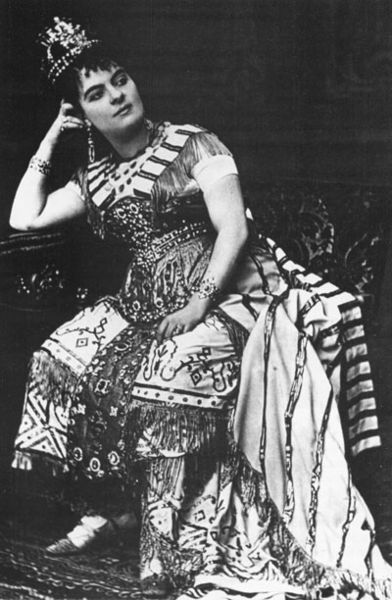 |
| @Wikipedia |
Elena Sanz y Martinez de Arrizala (1844-1898)
Lover in 1872.
Spanish opera singer.
Daughter of: Juan Caycedo y Sanz Jurado & Jenny Martinez de Arrizala.
Daughter of: Juan Caycedo y Sanz Jurado & Jenny Martinez de Arrizala.
Natural offspring:
1. Alfonso Sanz y Martinez de Arrizala (1880-1970)
1. Alfonso Sanz y Martinez de Arrizala (1880-1970)
2. Fernando Maria Sanz y Martinez de Arrizala (1881-1922)
Elena's physical appearance.
"Castelar described her as 'with red lips, dark brown, white teeth, black hair shining like jet, nose turned up and open, neck fleshy and turned to wonder, broad forehead like that of an Egyptian deity, the black and unfathomable eyes like two abysses that call to death and love'." (Wikipedia)
Elena's physical appearance.
"Castelar described her as 'with red lips, dark brown, white teeth, black hair shining like jet, nose turned up and open, neck fleshy and turned to wonder, broad forehead like that of an Egyptian deity, the black and unfathomable eyes like two abysses that call to death and love'." (Wikipedia)
"Alfonso XII, as a teenager, studied in a publishing school in Vienna, at the time that the triumphant singer Elena, traveled in Europe, triumphant, and arrived in Vienna to perform at the Imperial Theater. In Vienna, she paid a courtesy visit to the then prince Alfonso, a fifteen-year-old teenager, who was impressed by the opera singer, fifteen years older than him. . . Alfonso XII, a widower, is forced by his dignity to inaugurate the season of the Teatro Real and there begins a meeting that ended in passion, Alfonso and Elena, they fell in love, she left her opera career, and they started a relationship, where she became the other, my dear, who lived in an elegant villa in Paris, which was given to her by her lover, from this relationship were born two bastard sons "Alfonso and Fernando'. Being pregnant Elena of Alfonso XII, this contracted second nuptials with Maria Cristina de Habsburgo-Lorraine in 1879, Elena's eldest son was born in 1880, two months after his father had married another woman who became queen consort. The new queen, supported that his mother-in-law the queen Isabel, would sponsor to the illegitimate grandson and she referred to Elena like "my daughter-in-law before God'. The king suffering from tuberculosis had an early death, Elena as a lover and the queen consort, Maria Cristina, reached an agreement for mutual benefit. Elena sold the love letters to the Crown to be destroyed and she changed the status of her two children, and María Cristina accepted to preserve that of her daughters and her posthumous son, Alfonso XIII. Elena Sanz was the most lasting and perhaps beloved mistress of Alfonso XII as well knew the suffering Queen Maria Cristina of Habsburg-Lorraine and the entire court, although it condescendiera with the gallant adventures of the young king." (Elena Sanz, una de las amantes de un rey)
"Another of Alphonso's favorites was a dancer called Elena Sanchez, who bore him two bastards. On his deathbed, she and his wife, Maria Christina, stood side by side to pay their final respects. When the King died his wife was pregnant. The baby was born King Alphonso XIII in May 1886, under the Regency of the Queen Mother. The boy-king grew up to be odd-looking even for a Spanish Bourbon. He was physically puny, tubercular, unnaturally pale, and in addition to his huge Bourbon nose had a very pronounced jawline. In spite of his runtish appearance it quickly became apparent that there was some hot Bourbon blood coursing beneath his corpse-like complexion." (Royal Babylon: 114)
"Another difficulty the Regent had to settle was that of Elena Sanz and her two sons by King Alfonso XII. He had left them generous sums of money in his will, but the Queen did all she could to prevent any payments being made. Elena was banished from Spain and settled in France, and after several months of negotiations it was agreed that she should receive a sum of around 738,000 francs in compensation. The payments were delayed on the order of the Queen and Elena died almost impoverished in Nice in 1898. Her sons, who went to live in Mexico, took out a court case against the Queen in 1907, which was successful in obtaining them a certain amount of extra money." (Divided Kingdom)
"Another of Alphonso's favorites was a dancer called Elena Sanchez, who bore him two bastards. On his deathbed, she and his wife, Maria Christina, stood side by side to pay their final respects. When the King died his wife was pregnant. The baby was born King Alphonso XIII in May 1886, under the Regency of the Queen Mother. The boy-king grew up to be odd-looking even for a Spanish Bourbon. He was physically puny, tubercular, unnaturally pale, and in addition to his huge Bourbon nose had a very pronounced jawline. In spite of his runtish appearance it quickly became apparent that there was some hot Bourbon blood coursing beneath his corpse-like complexion." (Royal Babylon: 114)
"Another difficulty the Regent had to settle was that of Elena Sanz and her two sons by King Alfonso XII. He had left them generous sums of money in his will, but the Queen did all she could to prevent any payments being made. Elena was banished from Spain and settled in France, and after several months of negotiations it was agreed that she should receive a sum of around 738,000 francs in compensation. The payments were delayed on the order of the Queen and Elena died almost impoverished in Nice in 1898. Her sons, who went to live in Mexico, took out a court case against the Queen in 1907, which was successful in obtaining them a certain amount of extra money." (Divided Kingdom)
Alfonso XII Gallery.
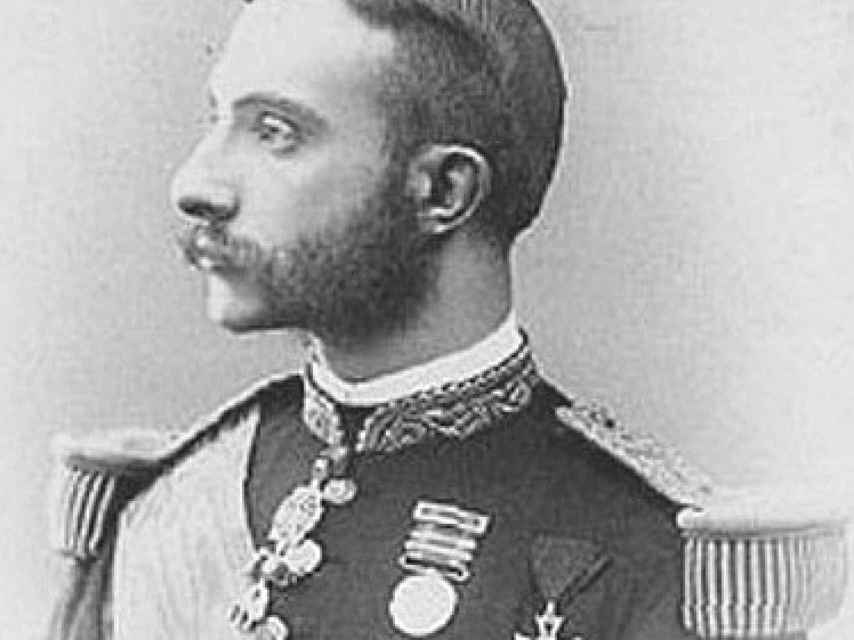 |
| @El Espanol |
 |






(1886-1941)
King of Spain
1886-1931
Son of: Alfonso XII de España & Maria Cristina of Austria.
Husband of: Victoria Eugenia of Battenberg.
Marital relations had virtually ceased for several years.
Marital relations had virtually ceased for several years.
"By this stage of her husband's reign, Queen Ena's situation had become increasingly uncomfortable. She had long since realised that her mercurial, restless husband soon tired of everything. Marital relations had virtually ceased for several years, and apart from their love of sporting activities and the outdoor life they had very little in common. Had it not been for her reserved demeanour, the poor health of most of their sons, her persistent Englishness and her wariness of Spain, maybe she could have held his affections. But they were like chalk and cheese. She was very quiet and gave off an aura of sadness, which contrasted markedly with his buoyant personality. That he was carrying on unashamedly with other women, thus giving rise to unsavory gossip, gave her further cause for unhappiness." (Divided Kingdom: The Spanish Monarchy)
Alfonso's resumption of wanton bachelor lifestyle.
" . . . Following in Boris's footsteps, Alfonso fathered his first child out of wedlock at age eighteen. On May 31, 1906 he married Princess Eugenie of Battenberg, daughter of Royal Princess Beatrice. The couple produced six children within eight years. Shortly after Infante Gonzalo's birth in October, 1914, the King cast Eugenie aside for infecting Spain's dynasty (princes Alfonso and Gonzalo) with hemophilia. By that ploy he aimed to justify the resumption of his wanton bachelor lifestyle. Over the next twenty-five years Alfonso indulged in affairs with Melanie de Gaufridy de Dortan, Pauline St. Glen, Beatrice Noon, Juana Alfonsa Milan y Quiñones de Leon, Maria del Carmen Ruiz y Morgas, and Maria Sousa. Those adulteries generated five more illegitimate offspring. But whatever his faults as a husband, Alfonso tried harder than most European monarchs to aid the Romanovs/" (Fifty-Seven Years of Russian Madness)
The royal procurer of mistresses.
"The Queen's greatest bete noire at court, the Marques de Viana, had been a close friend of the King since his early adult life. The Marques had been one of the privileged guests invited to witness Ena, before her marriage, officially embracing the Roman Catholic faith at Miramar. Notoriously prejudiced against foreigners, he always resented the fact that his King had married an Englishwoman. In order to help satisfy his master's appetites, he undertook to ensure that Alfonso had enough young women to provide him with the amusements that he considered the Queen could not offer. Within a few years of her marriage, the Queen was convinced that the Marques was her greatest enemy at court. (Divided Kingdom)
Like father, like son.
"The Queen's last pregnancy, in 1918, ended in a miscarriage. By then the King had already been indulging himself elsewhere, not only with ladies brought to court by Viana, but also with those he sought out in Madrid's high-class brothels, or in Paris under the incognito of Monsieur Lamy. Queen Maria Cristina, who had been well aware of her husband's promiscuity, was not surprised to find that her son had gone the same way. She once told her sister that if she had to pick out all the grandchildren credited to her, she would not live long enough to be able to do so." (Divided Kingdom)
Alfonso XIII's string of mistresses.
The King was reputed to have had his first extra-marital affair around 1908 (or earlier), with an Irish nurse who was sent away from Spain once it was realised she was pregnant. Rumour has it that the daughter born of this affair committed suicide at a young age. There there were various ladies from Paris, notably Madame Melanie de Vilmorin, wife of a French wheat dealer, who bore the King a son, Roger, in 1915. She was soon followed by a Scottish lady, Beatrice Noon, piano teacher to the young princesses, who was also sent to France once enceite and gave birth to a daughter in 1916. Of all his mistresses, his affair with the actress Carmen Ruiz Moraga was the most serious. He first met her in 1916, but his relationship with her only started about seven years later, after she had separated from her husband, Rodolfo Gaona, a Mexican bullfighter. She bore him two children, Maria Teresa, born in 1925, and Leandro Alfonso four years later." (Divided Kingdom)
Alfonso XIII's string of mistresses.
The King was reputed to have had his first extra-marital affair around 1908 (or earlier), with an Irish nurse who was sent away from Spain once it was realised she was pregnant. Rumour has it that the daughter born of this affair committed suicide at a young age. There there were various ladies from Paris, notably Madame Melanie de Vilmorin, wife of a French wheat dealer, who bore the King a son, Roger, in 1915. She was soon followed by a Scottish lady, Beatrice Noon, piano teacher to the young princesses, who was also sent to France once enceite and gave birth to a daughter in 1916. Of all his mistresses, his affair with the actress Carmen Ruiz Moraga was the most serious. He first met her in 1916, but his relationship with her only started about seven years later, after she had separated from her husband, Rodolfo Gaona, a Mexican bullfighter. She bore him two children, Maria Teresa, born in 1925, and Leandro Alfonso four years later." (Divided Kingdom)
Alfonso XIII's lovers were:
1) Beatrice Noon (1895-?)
Lover in 1910.
Irish governess of royal children.
Natural offspring:
Natural offspring:
a. Juana Alfonsa Milan y Quinones de Leon (1916-2005)
2) Carolina Otero.
"On a visit to Monte Carlo in 1905, Otero 'deflowered' 19-year-old King Alfonso XIII of Spain. 'He was rather aloof at first,' she remembered, 'but I taught him how to relax.' In 1913, at the age of 27, he set the 44-year-old Otero up in Madrid in the last apartment she would ever occupy courtesy of a royal client." (The Intimate Sex Lives of Famous People: 509)
3) Celia Gamez.
3) Celia Gamez.
Spanish movie star.
4) Genoveva Vix.
4) Julia Fons.
5) Leticia Bosch.
4) Genoveva Vix.
4) Julia Fons.
5) Leticia Bosch.
5) Lili Damita (1901-1994)
French movie actress
"When sailing on the Paris to New York in 1934, Flynn had a fateful shipboard romance with the petite, athletic, cosmopolitan, dynamic and fiery Lili Damita. He impressed her with exaggerated accounts of his adventures in New Guinea, and she dazzled him with her glamour and sophistication. Her uninhabited personality strongly appealed to him. When someone admired her tight-fitting blue dress, she replied: 'If monkeys have blue asses, I can have blue tits!' Born Liliane Carre in Bordeaux in 1901, the daughter of an actress, she later adopted the name Damita, which means 'little lady' in Spanish. Educated in various convents in Portugal, Spain and Greece, while her mother performed in the capitals of Europe, she began her career as a teenage model for hand-colored postcards. After studying ballet in Belgium, she danced with the Paris Opera, entertained French troops in World War I, became a music hall performer and succeeded the famous Mistinguett as star of the Casino de Paris review. Lili made fourteen French and German silent films between 1921 and 1928, including three for the Hungarian Michael Curtiz, who later directed many of Flynn's best movies at Warner Bros. In Europe, she was the mistress of King Alfonso XIII of Spain, and a friend (perhaps lover) of Marlene Dietrich in Berlin. Brought to Hollywood in 1928 by Sam Goldwyn to replace Vilma Banky, she made her American debut with Ronald Colman in The Rescue, a 1929 screen adaptation of Conrad's novel. One of the few foreign actresses to make the transition from silent to sound movies, she played leading roles in a number of early talkies, and made eighteen Hollywood movies from 1929 to 1936, including Fighting Caravans (1931) with Gary Cooper and The Frisco Kid (1935) with James Cagney." (Inherited Risk: Errol and Sean Flynn in Hollywood and Vietnam)
"Even before arriving in Hollywood, Lili Damita's love affairs were already notorious. She'd been the mistress of King Alfonso XIII of Spain, the lover of both those 'switch-hitters,' Mistinguette and Maurice Chevalier in Paris, and the lesbian protege of Marlene Dietrich in Berlin." (The Secret Life of Humphrey Bogart: The Early Years (1899-1931): 516)
"Lili Damita: Liliane Marie Madeleine Carre (1901-1994), Fr. movie actress. The actress claims she first changed her name after king Alfonso XIII of Spain (who became her lover) saw her on the beach at Biarritz and enquired after the damita (young lady) in the red bathing dress [The Times, April 4, 1993]. She was thus originally Damita del Rojo, 'young lady in red,' and then for a while Lily Deslys ('lily of the lilies') before settling for Lili Damita in 1923." (Dictionary of Pseudonyms: 13,000 Assumed Names and Their Origins, 5th ed.: 130)
"Damita was a Frenchwoman of great beauty who radiated style, wit and intelligence. In the mold of foreign sophisticates like Garbo and Dietrich, she was a leading lady of silents and early talkies whose tempestuous marriage to Errol Flynn made bigger headlines. Nee Lilian Carre in Bordeaux, she got her state name by being the mistress of Alfonso XIII. 'Petite dame' was what the king of Spain called the former chorus girl. Diane Vreeland, who met the king before he was exiled in 1936, called him 'the most exciting man I've ever seen.'" (The Sewing Circle: Hollywood's Greatest---Females Stars Who Loved Other Women)
6) Madelaine Boisguillaume.
 |
| Carmen Ruiz Moragas |
7) Maria del Carmen Ruiz Moragas (1898-1936).
Lover in 1916.
Spanish actress.
Daughter of: Don Leandro Ruiz Antolin Martinez, Civil Governor of Granada, & Dona Mercedes Moragas.
Wife of: Rodolfo Gaona, Matador. mar ?, div 1919
Her other lover was:
Juan Chabas.
Spanish poet and writer.
Natural offspring:
Natural offspring:
1. Ana Maria Teresa Ruiz y Moragas (1925-1965)
2. Leandro Alfonso Luis Ruiz y Moragas. (1929-2016)
7) Marie Sousa.
7) Marie Sousa.
Natural offspring:
1. Alonso de Borbon-Sousa (1930-1934)
 |
| Marthe, Princess Bibesco |
Romanian-French writer.
Daughter of: Ioan Lahovary & Princess Emma Mavrocordat.
Wife of: Prince George III Valentin Bibescu (1880-1941) mar 1902
Daughter of: Ioan Lahovary & Princess Emma Mavrocordat.
Wife of: Prince George III Valentin Bibescu (1880-1941) mar 1902
Princess Bibesco's other lovers were:
"Whatever the psychological chemistry may have been in each case, the list of admirers, lovers or would-be lovers is an impressive one. It included Crown Prince Wilhelm of Germany (whose intimacies with her included the memorably bathetic (sic) Prussian compliment: 'I love your hands - not too soft, not too hard'); the Prince de Beauvau-Craon, who almost persuaded her to get a divorce and marry him; Henri de Jouvenel, the editor of Le Matin; Christopher Thomson, a British officer in Romania who became Lord Thomson, was Air Minister and died in the crash of his great project, the airship R101; and King Alfonso XIII of Spain." (Telegraph)
2) Charles-Louis de Beauvau-Craon
Lover in 1909.
2) Charles-Louis de Beauvau-Craon
Lover in 1909.
3) Christopher Thomson, 1st Baron Thomson.
4) Wilhelm von Preussen, Crown Prince of Germany (1882-1951)
5) Henri de Jouvenel des Ursins (1876-1935)
Journalist
6) Ramsay MacDonald (1866-1937)
"Most bizarre - and most touching - of all was the passionate devotion shown to her by Ramsay MacDonald during his premiership: he was writing to her from downing street or Chequers several times a week, his letters beginning 'You of the fairy swanland, who lives in my dreams. . .'.' (Telegraph)
"Most bizarre - and most touching - of all was the passionate devotion shown to her by Ramsay MacDonald during his premiership: he was writing to her from downing street or Chequers several times a week, his letters beginning 'You of the fairy swanland, who lives in my dreams. . .'.' (Telegraph)
Marthe, Princess Bibesco Gallery.
9) Melanie de Gaufridy de Dortan (1876-1935)
Natural offspring:
a. Roger Leveque de Vilmorin (1905-1980)
Wife of: Philippe de Vilmorin (1872-1917), French botanist & plant collector.
Natural offspring: 1. Roger Marie Vincent Philippe Lévêque de Vilmorin (1905-1980)
10) Pauline de Saint Glen.
10) Pauline de Saint Glen.
Natural offspring:
a. Ch
| Juan Carlos of Spain |
Juan Carlos de España.
[YouTube]
 |
Husband of: Sofia of Greece.
"One day before the King and Queen of Spain landed in the United Kingdom, The Times published a page dedicated to the English delirium book about Amoros (4,786 exactly, according to the military) of Don Juan Carlos . The truth is that it does not contribute much to the neat bibliography that has already devoted to the subject The sphere of books. The retired colonel gives names known to all. Olghina de R., Marta G., Raffaela C., Paloma SB., Nadiuska, Lady D., Carmen D. de R., Anne I., Sandra M., or Julia S. The inclusion of Lady D is a bit surprising, so anyone who does not know the avatars of SM could question the entire text. Already in Ladies of Spain. Sofia, Elena, Cristina and Letizia: between duty and love, the book that Andrew Morton dedicated to the Spanish Monarchy, it was published that Lady D herself had denied the writer that something happened with the august Emeritus in Marivent, beyond the classic flirt that Don Juan Carlos usually devotes to any woman who does not have three arms. Or who knows In certain trances, another limb can be very useful." (Las cuentas de amantes del Rey Juan Carlos no le salen al coronel)
"One day before the King and Queen of Spain landed in the United Kingdom, The Times published a page dedicated to the English delirium book about Amoros (4,786 exactly, according to the military) of Don Juan Carlos . The truth is that it does not contribute much to the neat bibliography that has already devoted to the subject The sphere of books. The retired colonel gives names known to all. Olghina de R., Marta G., Raffaela C., Paloma SB., Nadiuska, Lady D., Carmen D. de R., Anne I., Sandra M., or Julia S. The inclusion of Lady D is a bit surprising, so anyone who does not know the avatars of SM could question the entire text. Already in Ladies of Spain. Sofia, Elena, Cristina and Letizia: between duty and love, the book that Andrew Morton dedicated to the Spanish Monarchy, it was published that Lady D herself had denied the writer that something happened with the august Emeritus in Marivent, beyond the classic flirt that Don Juan Carlos usually devotes to any woman who does not have three arms. Or who knows In certain trances, another limb can be very useful." (Las cuentas de amantes del Rey Juan Carlos no le salen al coronel)
His lovers were:
2) Barbara Rey.
Actress.
3) Lilian.
3) Lilian.
Belgian governess.
Lover in 1956
Natural offspring:
Ingrid Sartiau
Belgian gallerist
) Carmen Díaz de Rivera.
8) Julia Steinbusch.
9) Maria Gabriella de Saboya.
10) Marta Gaya.
An interior designer.
11) Nadiuska.
Romanian actress.
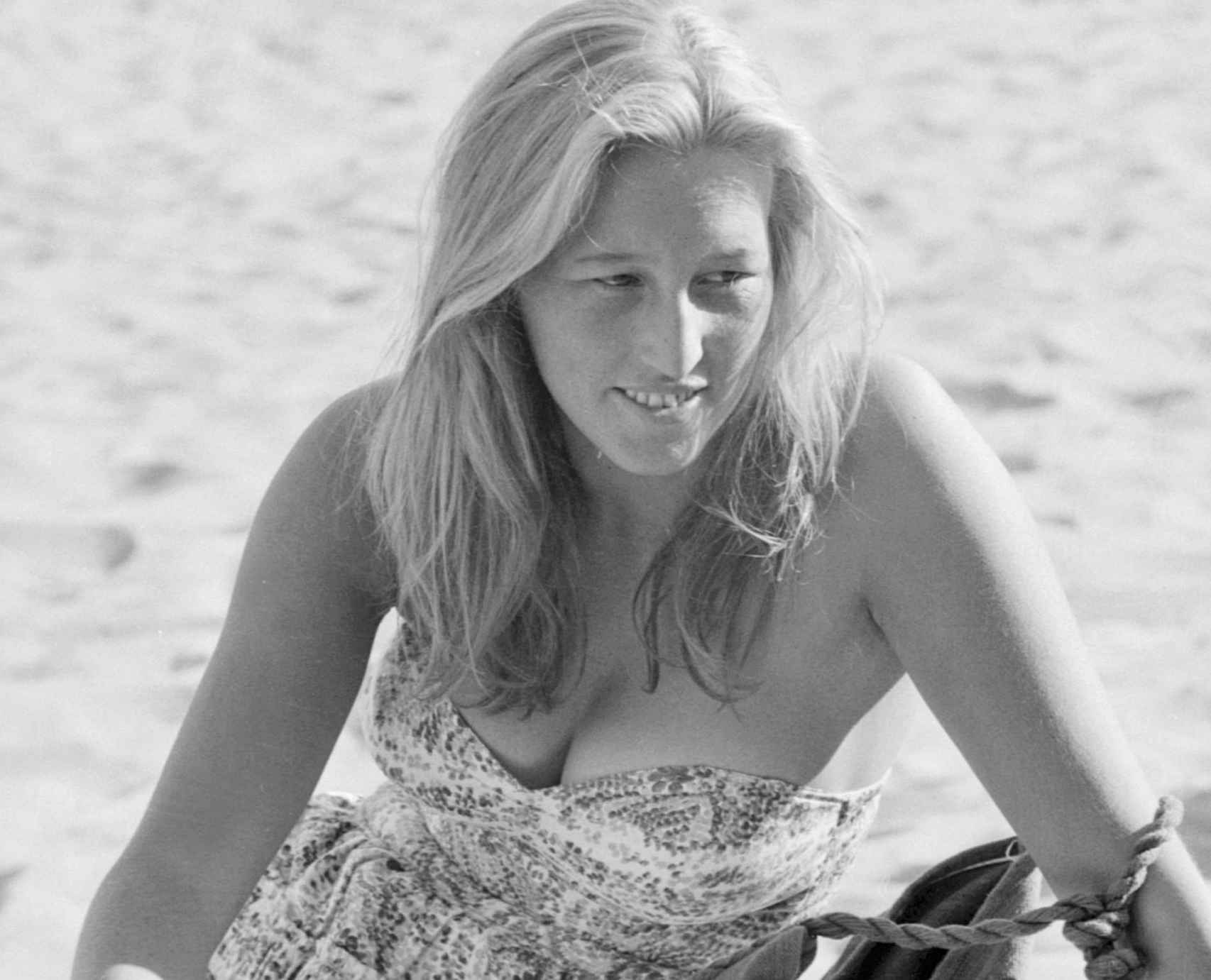 |
| @El Espanol |
12) Olghina Micolis de Robilent.
Italian aristocrat.
13) Paloma San Basilio (1950-Present)
Spanish singer
Latin Grammy Award for lifetime excellence in Spanish music
Wife of: Jose Ignacio Gomez Pellico
14) Raffaella Carra.
Singer.
15) Sandra Mozarowsky (1958-1977)
Spanish actress
Daughter of: A Russian father & a Spanish mother.
"Alternative theories and speculations have been rife ever since her death, partly due to her acquaintances' adamant unwillingness to accept the suicide verdict and the overall lack of consensus on the circumstances of her fall. Most, if not all of these theories are centered on a rumored affair with King Juan Carlos I, followed by a pregnancy, her refusal to terminate it and the subsequent intervention of third parties linked to secret service operatives and/or Royal House security staff. A seemingly impromptu negative opinion on abortion, out of keeping with the rest of the conversation, did find its way to a printed copy of an interview she gave shortly before her death." (Wikipedia)
16) Sara Montiel.
Felipe VI de España.
[Ref]

His lovers were:
1. Victoria Carvajal y Hoyos.
a.k.a. Vicky.
 |
| @Hola |
 |
2. Isabel Sartorius.
Daughter of:Marques de Mariño.
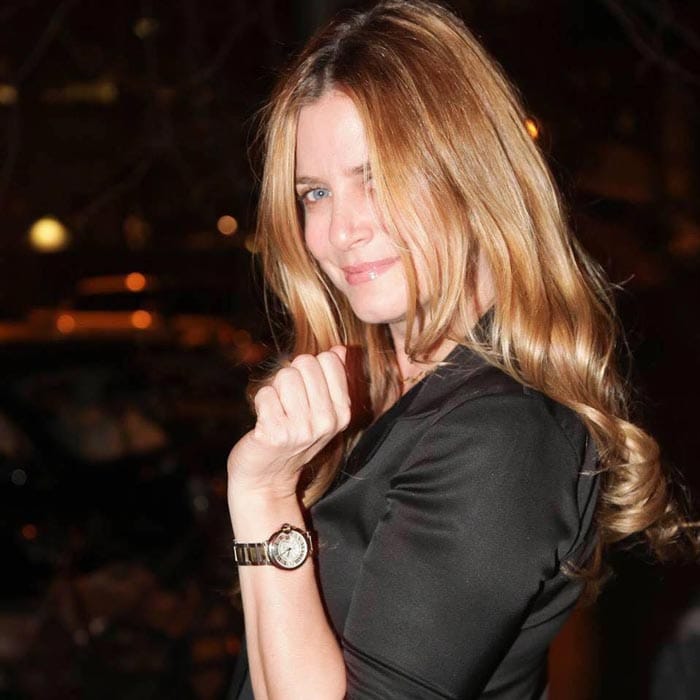 |
| @Hola |
3. Giselle Howard.
a.k.a. Gigi Howard.
"Although he is now happily married to Queen Letizia, in his youth, King Philip VI's heart belonged to Giselle Howard, an American girl he met while studying at Georgetown University. Her relationship with the son of Juan Carlos of Spain did not thrive after photographs of both vacationing in the Caribbean came to light. But far from the sentimental wound of the moment, Gigi is glad she didn’t become Queen Consort because she does not consider herself a woman capable of dealing with photographers and the press. "My grandmother said that a good person can only appear once in the press ... in the obituary section," Gigi jokes in an interview she gave to Vanity Fair, 20 years after she met the Prince. Unfortunately for her, she could not fulfill her grandmother's advice when at Easter 1995, her vacation with the then Prince, accompanied by the Prince of Greece and his now-wife Marie Chantal, became known internationally. The situation reached the courts where they accused the photographer Carlos Hugo Arriazu of having intervened the telephone line of the monarch and led to Gigi to testify before the judge." (Hola)
"Although he is now happily married to Queen Letizia, in his youth, King Philip VI's heart belonged to Giselle Howard, an American girl he met while studying at Georgetown University. Her relationship with the son of Juan Carlos of Spain did not thrive after photographs of both vacationing in the Caribbean came to light. But far from the sentimental wound of the moment, Gigi is glad she didn’t become Queen Consort because she does not consider herself a woman capable of dealing with photographers and the press. "My grandmother said that a good person can only appear once in the press ... in the obituary section," Gigi jokes in an interview she gave to Vanity Fair, 20 years after she met the Prince. Unfortunately for her, she could not fulfill her grandmother's advice when at Easter 1995, her vacation with the then Prince, accompanied by the Prince of Greece and his now-wife Marie Chantal, became known internationally. The situation reached the courts where they accused the photographer Carlos Hugo Arriazu of having intervened the telephone line of the monarch and led to Gigi to testify before the judge." (Hola)
4. Viviana Corcuera.
5. Yasmeen Ghauri.
6. Tatiana de Liechtenstein.
7. Victoria de Borbon Dos Sicilias.
8. Carolina de Waldburg.
9. Esmeralda Iacobella Macioti.
10. Eva Sannum.
"Spain's Most Wanted Woman www.spainview.com/sannum.html
Eva Sannum
Is she destined to become the future queen of Spain?
The talking point in Spain - or, more specifically, in Spain’s gossip magazines - is whom the heir to the throne, the personable prince Felipe, will choose as his bride. By all accounts the prince has an eye for the ladies - he prefers blondes - but has so far failed to decide on a candidate.
Although an 18th-century law states that the heir to the crown must marry royalty, few believe this would be an obstacle to the prince’s marrying whomever he chooses, so long as she doesn’t have a past and isn’t an embarrassment at the palace.
Norwegian beauty Eva Sannum moved up in the princess stakes in late autumn, 2000, when the more staid of the Spanish weekly gossip magazines, Hola!, published a report on a summer 1999 visit by Prince Felipe and Eva to India. The couple were shown posing in front of the Taj Mahal and, in another photo, riding an elephant. The couple were visiting India with a group of friends, one of whom - given the all-smiles, family album snapshot character of the pictures - presumably leaked the photos to Hola!
Madrid rumour mills shifted into overdrive in March 2001 when new photographs of the couple skiing together in Saint Moritz showed the flame was very much alive. The press reported that since September 2000 Ms. Sannum had all but abandoned her carreer as a professional model. Some royal watchers suggested there might be a wedding in June, at Madrid's Almudena basilica, while another rumour stated that the Spanish royal family had reserved all the rooms in the Spanish capital's luxurious Ritz hotel for October, presumably to house wedding guests (the hotel denied the report).
Eva Sannum was born on April 27, 1975 in Lovenstad, northern Norway, and is seven years the prince's junior. When she was ten years old her parents divorced, and she and her older sister Linda lived with her father, Bjorn, owner of a automobile paint workshop, who eventually remarried. From the age of 15 Eva worked as a fashion model (women’s lingerie), and later went on to study advertising at Oslo University. She speaks six languages aside from Norwegian (English, Spanish, German, French, Greek, and Italian).
This is not the first women to be mooted as the love of Prince Felipe’s life and, therefore, a candidate to be the future queen of Spain. The newspaper El Mundo has counted up to twelve so far, including an American entry, Gigi Howard. Among the most recent claimants are Carolina de Borbón, niece of Queen Beatrix of Holland. Another recent candidate was Gabriela Sebastián, daughter of the Spanish ambassador to Germany and his Austrian aristocrat wife, and nine years the Prince’s junior.
The strongest candidate to date has been Isabel Sartorius, the attractive daughter of a Spanish aristocrat, but the romance ended (some gossips claim Queen Sofia didn’t approve) and Miss Sartorius eventually married someone else.
Prince Felipe met Eva Sannum in fall of 1997, when she was living in Madrid, where she had come to learn Spanish. The couple were photographed together at a dinner party, and that immediately got the royalty-watchers’ tongues wagging. Apparently Eva couldn’t take the constant pestering by Spain’s paparazzi, and returned to Oslo after three months in Madrid, but the royal liaison didn’t end there. Aside from the India trip, they have since been spotted or reported skiing in Frognersetren (Norway), going to a movie together in Oslo - to see Oh, Brother!, starring George Clooney -, spending ten days in summer 2000 at the exclusive resort of Sotogrande, on the southern coast of Spain, where they went sailing after Felipe sneaked away from Mallorca where the royal family where spending their summer holiday, and, in autumn 2000, holidaying on a Caribbean island.
Hola!, which stated that the India photographs "demonstrate that the friendship which started three years ago has continued and strengthened over time", is one of the more respected of Spain’s weekly gossip magazines, but the Barcelona newspaper La Vanguardia points out that Hola! does not have a direct line to the royal palace, and reminds readers that on a March 1995 cover it announced that Tatiana of Liechtenstein was destined to become the future queen of Spain.
Many feel that, with the Prince in his thirties, time is running out. His two older sisters have both married and produced royal offspring. Meanwhile, identifying the Prince’s current beau has become something of a gold mine when it comes to selling gossip magazines." (Royal Forums)
11. Marcela Cuevas.
12. Alicia Krezjlova.
13. Gabriela Sebastián de Erice.
11. Marcela Cuevas.
12. Alicia Krezjlova.
13. Gabriela Sebastián de Erice.
14. Gabriella Windsor.
15. Mencía Roca de Togores Lora.
16. Diana Martínez Bordiú Azana.
a.k.a. Didi
17. Flor de María Valero.
18. Anna Jussil.
19. Christine von Wangenheim.
20) Gwyneth Paltrow.
References.
[Ref] arles-Maxime-Victor e Saint-Glen (1914-1934)
The Other Family of Felipe IV @tiempohoy
[Fam1:Geneall][Ref1:313] [Ref2] [Ref3] [Ref4] (Soniak, 2011) [Ref1] [Ref2] [Ref3:25] [Ref4:17] [Ref1] [Ref2:25]
[Jetset] [infobae] [La Cuarta] [Clarin] [Diario Femenino] [A Micro Abierto] [LacrimaSeca] [Samuel, not the biblical one] [ecorepublicano] [el digital de canarias]





